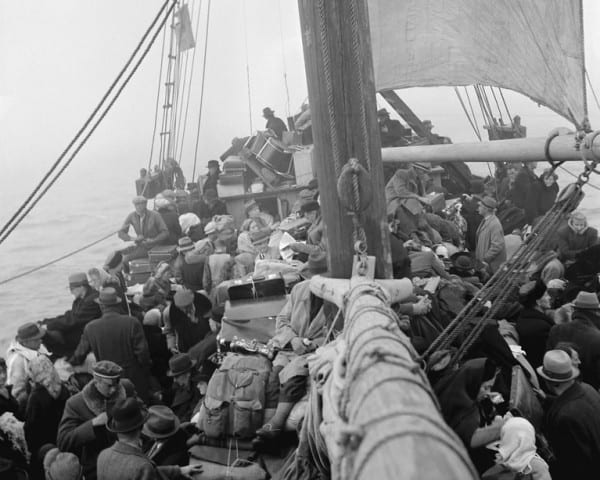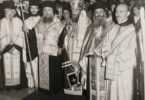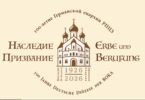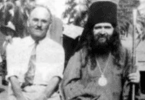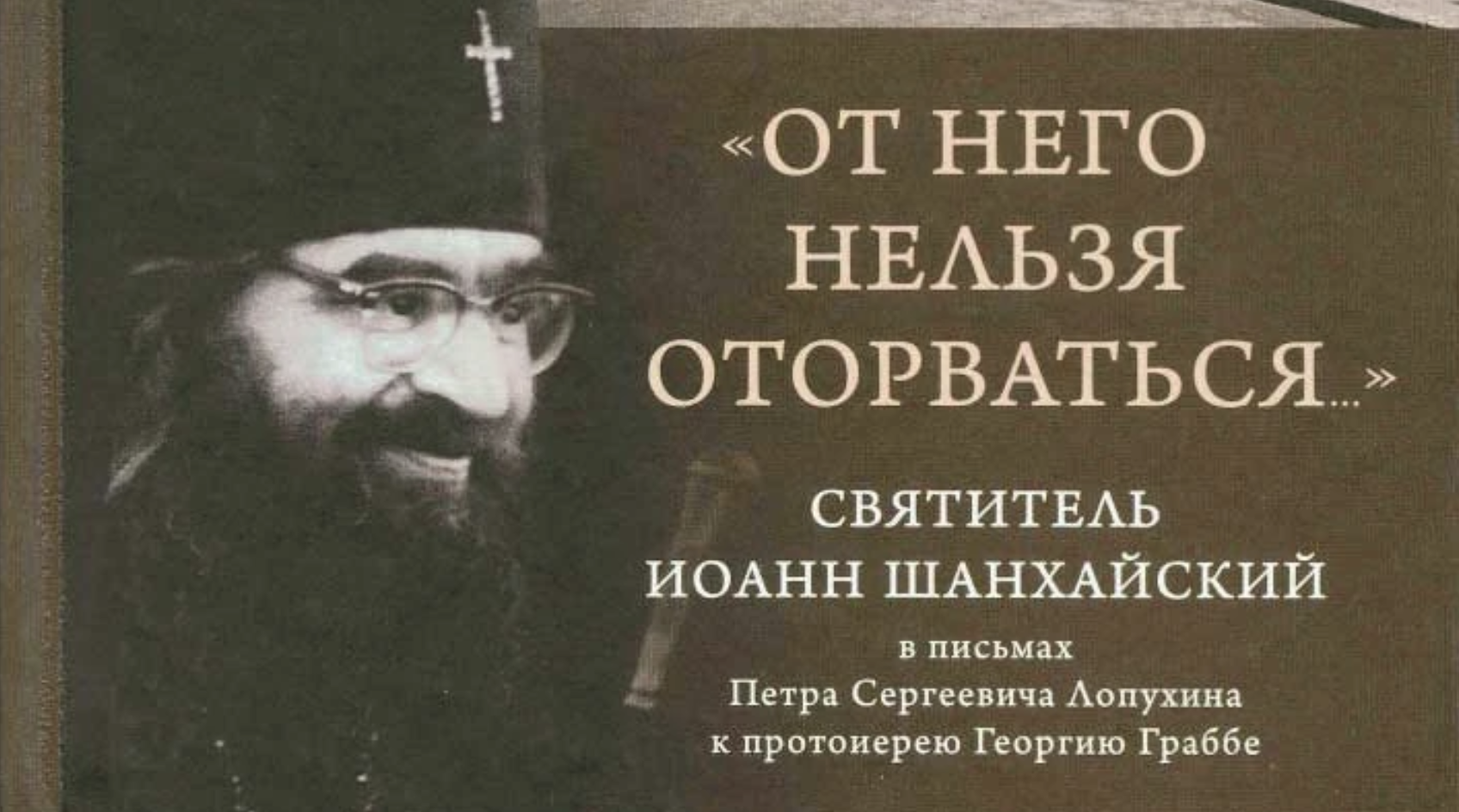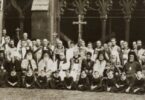The article below was published in the scholarly-analytical journal Pravoslavie v Baltii [Orthodoxy in the Baltic Lands], no. 3 (12), (Riga, 2015): 11-48. It is published here with the editors’ permission. The author has made additional amendments to the article for our site, providing the precise archival reference numbers of most of the items in the archives of the German Diocese. The majority of the clergy mentioned in the article migrated to America in the late forties and early fifties. The publication of this article is dedicated to Professor A. V. Gavrilin, the creator and invaluable editor of Pravoslavie v Baltii, who reposed in Riga on June 20, 2019.
A Brief Overview of Orthodoxy in Latvia, Lithuania, and Estonia between the Two World Aars
From among the significant portion of the population who were removed from the Baltic lands by the Nazi regime in order to work in Germany, or who were evacuated or fled to the dying Third Reich, thousands of Orthodox Lithuanians, Latvians, and Estonians found themselves outside their native lands. In September 1944, Metropolitan Augustins (Petersons),[1]Augustins (Petersons, 1873-1955) was Metropolitan of Riga and All Latvia from 1936. Between 1936 and 1941 and between 1947 and 1955 he was under the Ecumenical Patriarchate. In 1941 he transferred to … Continue reading head of the Latvian Orthodox Church (LOC), Metropolitan Alexander (Paulus),[2]Metropolitan Alexander (Paulus, 1872-1953) was head of autonomous Estonian Orthodox Church under the Russian Orthodox Church between 1920 and 1923, after which he was under the Ecumenical … Continue reading head of the Estonian Apostolic Orthodox Church (EAOC), and Bishop John (Garklavs) of Riga,[3]Archbishop John (Garklavs, 1898-1982) was consecrated to the episcopate on March 13, 1943 as Bishop of the Riga Baltic Exarchate of the Moscow Patriarchate. In 1944 he left Latvia with a group of … Continue reading as well as a few dozen Baltic priests, were evacuated to Germany.
Relations of the heads of the Estonian and Latvian Orthodox Churches with the Russian Orthodox Church Outside Russia (ROCOR) followed different paths. Metropolitan Augustins (Petersons) recognized the ROCOR and cooperated with it. Metropolitan Alexander (Paulus) stayed away from the ROCOR, although he did not ban his clergy from collaborating with the clergy of the German Diocese of the ROCOR. A significant portion of the Baltic clergy (including all of the Lithuanian clergy) joined the ROCOR in Germany. The LOC, which was transformed in 1947 into the Latvian Orthodox Church in the Emigration, ceased its existence in 1955 with the repose of Metropolitan Augustins (Petersons), who had taken care before that to hand over the care for his flock of the LOC to Archbishop Alexander (Lovchii),[4]Archbishop Alexander (Lovchii, 1891-1973), was consecrated as Bishop of Bad Kissingen, Vicar of the ROCOR Diocese of Germany on July 29, 1945. He became Archbishop of Berlin and Germany on April 11, … Continue reading head of the German Diocese of the ROCOR. The Orthodox Churches in Estonia (Decree of May 10, 1920) and in Latvia (Decree of June 21, 1921) received the right to considerable autonomy within the Russian Orthodox Church.[5]These decrees were passed by Tikhon (Belavin, 1865-1925), Patriarch of Moscow and All Russia from November 21, 1917 (o. S.) the first patriarch after the restoration of the patriarchate in Russia. He … Continue reading In 1922, the Council of the Estonian Orthodox Church under the leadership of Archbishop Alexander (Paulus), under pressure from the Estonian government and a radical section of the Estonian clergy, appealed to the Patriarch of Constantinople with a request to grant autocephaly to the Estonian Orthodox Church.[6]Pravoslavnaia Entsiklopedia [Orthodox Encyclopedia] (TsNTs RPTs [Center for Church Research of the Russian Orthodox Church]: Moscow 2000) v. 1, 499-501. On July 7, 1923 Patriarch Meletios[7]Meletios IV (Metaxakis, 1871-1935), Patriarch of Constantinople from February 2, 1921 to September 20, 1923. of Constantinople confirmed the new status of the EOC, transforming it into an autonomous ecclesiastical metropolitan region within the Patriarchate of Constantinople. The uncanonical transfer of the EOC into the Ecumenical Patriarchate was not recognized by the leadership of the Russian Orthodox Church, whose head was under arrest in Moscow at the time. After the bylaws of the Estonian Orthodox Church were registered by the Latvian Ministry of the Interior in August 1926, it was renamed the Estonian Apostolic Orthodox Church. The movement towards autocephaly within the EOAC caused division in the Estonian flock: “although outwardly everything seemed well, the entire interwar period was a time of sharp opposition between the Russian speaking part of the EAOC and supporters of the total ‘Estonization’ of the country’s Orthodox parishes.”[8]I. V. Petrov, Vopros o kanonicheskoi prinadlezhnosti pravoslavnykh prikhodov Baltii v 1940-1945 gg. [The Issue of the Canonical Jurisdiction of Baltic parishes from 1940 to 1945], published on March … Continue reading
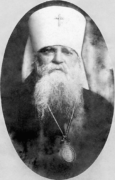
Metropolitan Eleftherios (Bogoiavlenskii)
A similar situation was repeated in the LOC with the difference that in Latvia movements towards autocephaly were restrained by the wise leadership of Archbishop John (Pommer).[9]Hieromartyr John (Pommer, 1876-1934), Archbishop of Riga and All Latvia, was Primate of the LOC from 1921 to1934. He was glorified by the ROCOR in 1981, and by the LOC and the ROC in 2001. See … Continue reading However, following his martyrdom on October 12, 1934, again under pressure from governmental organs, the LOC chose the course of separation from the Moscow Patriarchate. An assembly of clergy and laity of the LOC held on May 31, 1935 petitioned the Patriarch of Constantinople to receive the LOC into his jurisdiction without the approval of the Moscow Patriarchate, which had been attempting to solve the issue of the further fate of the Latvian Church by entrusting the temporary administration of the LOC to Metropolitan Eleftherios (Bogoiavlenskii)[10]Metropolitan Eleftherios (Bogoiavlenskii, 1868-1940) was consecrated as Bishop of Kaunas, Dean of the Diocese of Lithuania on August 21, 1911. He was head of the Diocese of Lithuania from 1917 on, … Continue reading of Vilnius and Lithuania. Patriarch Benjamin[11]Benjamin (Psomas Kiriakou) (1871-1946) was Patriarch of Constantinople from February 18, 1936 to February 17, 1946. accepted the LOC into the Patriarchate of Constantinople. Archpriest Augustins Petersons was consecrated as Bishop of Riga and All Latvia on March 29, 1936 and was then elevated to the metropolitanate. These events strengthened the position of the autocephalists in Latvia. The strengthening of this position was also enhanced by the regime of Latvian president Karlis Ulmanis,[12]Karlis Ulmanis (1877-1942) was a Latvian political and governmental figure. He occupied the post of Prime Minister of Latvia several times from 1918 on. Between 1934 and 1940 he was Latvia’s … Continue reading whose political lead Metropolitan Augustins followed in his attempts to reform the LOC.
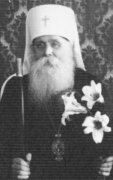
Metropolitan Augustins (Petersons)
Metropolitan Augustins reform of totally translating services into Latvian and his attempt to shift the LOC to the new calendar style were not successful, driving most of the parishioners away from the Church. Moreover, “his authoritarian administrative methods… efforts to reform the LOC in accordance with governmental ideology turned many of the Orthodox in Latvia against the head of the Church.”[13]A. V. Gavrilov, “Dokumenty po delu mitropolita Rizhskogo i vseia Latvii Avgustina (Petersonsa) ‘Latviiskoi papki’ arkhiva Arkhireiskogo Sinoda Russkoi Pravoslavnoi Tserkvi Zagranitsei.” … Continue reading After the downfall of Karlis Umanis‘ political regime, Metropolitan Augustins lost most of his supporters as well.
The situation in Lithuania’s Orthodox community differed strikingly from that in the LOC and the EAOC. The Diocese of Lithuania had been headed since 1917 by Metropolitan Eleftherios (Bogoiavlenskii), an active and consistent supporter of unity with the Moscow Patriarchate. Nor were there any nationalistic contradictions which could have given rise to tendencies towards creating a national church independent of Moscow. In contrast to Estonia and Latvia, where the titular nations comprised a significant portion of Orthodox parishioners, the number of Orthodox Lithuanians was very small. Most of the Orthodox in Lithuania were Russian, Belarusian, or Ukrainian. The authoritarian political regime of Antanas Smetona,[14]Antanas Smetona (1974-1944) was a political and governmental figure in Lithuania. He was the first president of the Lithuanian Republic from 1919 and 1920. From 1926 to 1940, he was dictator of the … Continue reading the leader of the “Union of Lithuanian Nationalists,” did not lead to the development of autocephalic aspirations in the Diocese of Lithuania and did not encroach upon the rights of the mostly Orthodox Russian speaking population, distinguishing it from similar regimes in neighboring Baltic republics.
Jurisdictional problems did exist, of course, on Lithuanian territory as well. After the collapse of the Russian Empire, the Lithuanian Republic formed on the territory of the province of Kaunas. The province of Vilnius ended up outside it, and the Republic of Central Lithuania was created with Vilnius at its center. In February 1922, Central Lithuania joined Poland, which led to the splintering of the Diocese of Lithuania. “The canonical territory of the Lithuanian Diocese of the Russian Orthodox Church turned out to be divided between two nations that were hostile to each other.”[15]Priest Vitalii Serpinas, ”Pravoslavnaia Tserkov’ v Litve v mezhvoennyi period, 1918-1939 gg.“ [The Orthodox Church in Lithuania in the Interwar Period, 1918-1039] Pravoslavie v Baltike no. 2 … Continue reading Archbishop Eleftherios of Vilnius and Lithuania lost half of his diocese and flock. When Central Lithuania joined the Lithuanian Republic in 1939, the question arose as to where the parishes of the former province of Vilnius belonged. Archbishop Theodosius (Feodosiev),[16]Theodosius (Feodoseev, 1864-1942) was Archbishop of Vilnius and Lida under the Polish Orthodox Church from 1923 to 1939. In 1939 he joined the Moscow Patriarchate and went into retirement until his … Continue reading formerly of Smolensk and Dorogobuzh, who had been in charge of the parishes in the province of Vilnius since May 1923, received the title of Archbishop of Vilnius and Lida, transferred to the Moscow Patriarchate, and was sent into retirement. Metropolitan Eleftherios returned from Kaunas to Vilnius, the former cathedral city of the Diocese of Lithuania. There was an idea among Archbishop Theodosius’ followers of creating a Lithuanian-Belarusian autonomous church under Constantinople, but this remained unrealized. Thus, the Diocese of Lithuania was the only diocese on Baltic territory to remain loyal to the Moscow Patriarchate.
Soon political events changed the jurisdictional situation of the Orthodox churches of Estonia and Latvia. In 1940, the Baltic republics became part of the USSR. The EAOP Synod, led by its primate, petitioned the locum tenens of the Patriarchal Throne, Metropolitan Sergius (Stragorodskii) of Moscow and Kolomna,[17]Sergius (Stragorodskii, 1867-1944). Patriarch of Moscow and All Russia from September 12, 1943 to May 15, 1944. He was Acting Locum Tenens of the Patriarchal Throne from 1925 to 1936 and Locum Tenens … Continue reading to join the ROC. Under pressure from the Latvian flock, Metropolitan Augustins likewise pursued rapprochement with Moscow. On March 29-30, the primates of the LOC and the EAOC publicly repented of the sin of schism in Moscow’s Cathedral of the Theophany and were accepted into the jurisdiction of the Moscow Patriarchate. From February 1941 to July 1944, the Orthodox Churches of Latvia and Estonia, as well as the Diocese of Lithuania, constituted part of the Baltic Exarchate of the Moscow Patriarchate, headed by Metropolitan Sergius (Voskresenskii),[18]Sergius (Voskresenskii, 1897-1944) was Bishop of Dmitrov from February 1936 (Archbishop from October 8, 1937) and administrator of the Moscow Diocese. From February 24, 1941 he was Metropolitan of … Continue reading and, after the tragic death of the latter on April 29, 1944 by Archbishop Daniel (Yuzviuk).[19]Archbishop Daniel (Yuzviuk, 1880-1965) took the position of temporary administrator of the Diocese of Vilnius and Lithuania with the rights of acting Patriarchal Exarch of the Baltic Lands, according … Continue reading The MP Exarchate for the Baltic Lands ceased to exist after the Nazis arrested Archbishop Daniel in July 1944 and interned him at the Friedrichswald Camp in Czechoslovakia. Metropolitans Augustins and Alexander played no practical role in the activity of the Exarchate. Having joined the Moscow Patriarchate and publicly repented of the sin of schism at the end of March 1941, both metropolitans distanced themselves from the Moscow Patriarchate after the beginning of the Nazi occupation. On July 20, 1941 Metropolitan Augustins (Petersons) announced the restoration of the LOC according to its 1940 status, that is under the jurisdiction of the Patriarchate of Constantinople. Metropolitan Augustins’ course of action met with practically no support in Latvia. On February 24, 1942 Metropolitan Sergius (Voskresenskii) dismissed him, and banned him from serving on July 15, 1942. On March 13, 1943 Metropolitan Sergius consecrated Archimandrite John (Garklavs) from Riga to the episcopate.
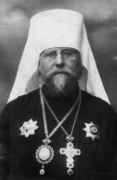
Metropolitan Alexander (Paulus)
In contrast to Latvia, where 70 percent of the Orthodox were Russian, the situation in Estonia was different, since Russian parishes in the EAOC made up only 25 percent of the total number of parishes, and the ecclesiastical policy of Metropolitan Alexander (Paulus) was widely supported by his Estonian speaking flock. On October 14, 1941 Metropolitan Alexander (Paulus) proclaimed himself Metropolitan of All Estonia. On May 11, 1942 the Exarch Sergius (Voskresenskii) decreed the removal of Metropolitan Alexander as head of the Estonian Diocese of the Baltic Exarchate and banned him from serving. But all of the Estonian parishes and some of the Russian ones continued to regard Metropolitan Alexander as head of the Estonian Church. The occupying German authorities did not impede his activity, although they forbade him from maintaining contact with Constantinople.[20]Pravoslavnaia entsiklopedia, loc. cit. Metropolitan Alexander’s former assistant Archbishop Paul (Dmitrovskii)[21]Archbishop Paul (Dmitrovskii, 1872-1946) was consecrated as Bishop of Narva (EAOC) on October 3, 1937. After canonical relations with the Moscow Patriarchate were restored in 1941, Bishop Paul … Continue reading and a portion of the Russian parishes in Estonia maintained canonical loyalty to the Baltic Exarch.
The fate of the EAOC and the LOC became a reflection and consequence of church events in the period starting with the acquisition of autocephaly by these Churches up to the time of their evacuation from the Baltic lands. Both Churches were not in the ROCOR and continued to regard themselves as under the jurisdiction of the Patriarchate of Constantinople. Basically, representatives of ethnic Estonian parishes and clergy who had supported his church policies back in Estonia ended up with Metropolitan Alexander once in Germany. Only one instance is known of an Estonian priest in Germany transferring to the ROCOR (Archpriest Nicholas Pavskii).[22]Archpriest Nicholas Pavskii, 1891-June 26, 1950) was born in the St. Petersburg province to a priestly family and graduated from the St. Petersburg Seminary in 1914. He was ordained to the diaconate … Continue reading For this reason, Metropolitan Alexander was able to organize an Estonian Orthodox community in Germany and also to preserve it after his emigration to Sweden. Metropolitan Augustins, on the other hand, lost his supporters in Germany as well, remaining alone at the end of his life and handing over care for the LOC to the German Diocese of the ROCOR.
As has already been noted, the purpose of this article is to examine documents in the possession of the Diocese of Germany of the ROCOR dealing with Baltic Orthodoxy. This subject includes documents on the history of the EAOC and the LOC and the service of individual priests on German territory whose lives were in one way or another connected with the Baltic region. Material on the clergy of the Vilnius Region, which belonged to Poland from 1920 to 1939, will not be examined in this work, since ecclesiastically this territory was under the Polish Orthodox Church. An exception has been made with documents concerning clergy who, when the Vilnius Region became part of Lithuania, transferred to the Lithuanian Diocese of the Moscow Patriarchate. It seems appropriate to organize the material in the article not according to the jurisdictional affiliation of church communities in the Baltic republics but according to geographical considerations, treating the Orthodox of Lithuania, Latvia, and Estonia separately.
Lithuania
The number of Lithuanians who found themselves in Germany as a result of the Second World War was somewhere between sixty and seventy thousand, of whom only 1.5 percent were Orthodox Christians.[23]The statistical data are from “Baltijas valstu beglu nometnes Vacija 1944-1951“ Lithuanians were distributed among 113 of the 269 German DP camps.[24]Abbreviation for ”displaced persons,” designating persons forced to abandon their permanent residences. The term gained widespread usage as a result of the events of the Second World War. In contrast to the Orthodox of Latvia and Estonia, Orthodox Lithuanians in Germany did not have their own administrative center or bishop. All of the clergy who were evacuated or fled to Germany from the Lithuanian Diocese, which had been in the Baltic Exarchate from 1941 to 1944 , joined the German Diocese of the ROCOR. In this connection, its archive (AGE) has no information regarding the life of Orthodox Lithuanians in DP camps and in Germany as a whole. An exception to this are documents regarding parishes of the German Diocese containing data on the national membership of communities. For instance, the item ”1948 Questionnaires of Parishes,” (AGE, F.3, Korobka 58, D.58/1) contains data that Orthodox Lithuanians were members of church communities in Hanau, (Hanau, DP Estnisches Lager I), Augsburg , Lübeck, Memmingen (Memmingen-Hiegerhorst DP Camp), Munich-Laima (DP Camp 1066), and Munich (St. Nicholas Church). But Baltic residents frequently identified themselves with the general term ”Balts.” The main sources regarding Lithuanian Orthodoxy in the German Diocesan Archive are the personal accounts of former clergy of the Lithuanian Diocese, thanks to which it is possible not only to trace the thorny path of these priests outside their native land, but also to find data on their service in Lithuania.
Archpriest Paul Savitskii
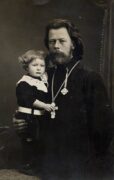
Archpriest Paul Savitskii with his daughter Nina; Vilno, 1915. Photo from the family archive of D.B. Zhdan
Archpriest Paul Savitskii (1882-1956) was the only priest of the German Diocese who was ordained in the Lithuanian Diocese of the Russian Orthodox Church before the Revolution. Fr. Paul’s personal file gives a detailed account of the brief period of his service in Lithuania from 1912 to 1916. According to his questionnaire data and service record, he completed the Lithuanian Seminary in 1905 and the Kazan Theological Academy in 1911.
He was then hired as a teacher at the Lithuanian Seminary, teaching schism and comparative theology. He was ordained to the priesthood on February 2, 1912 in Vilnius by Archbishop Agafangel (Preobrazhenskii)[25]Hieroconfessor Agafangel (Preobrazhenskii, 1854-1928), Bishop of Riga and Mitava (Archbishop from 1904) from October 4, 1897 to August 13, 1910. Archbishop of Lithuania and Bryansk from August 13, … Continue reading and appointed to Vilnius Cathedral. In 1915, he was awarded the nabedrennik for diligent service by Archbishop Tikhon (Belavin), the future Patriarch of Moscow and All Russia. After the German army occupied Vilnius in September 1915, Fr. Paul remained there to serve the remaining Orthodox and two army hospitals with the heavily wounded. According to Fr. Paul’s report to Metropolitan Seraphim (Liade),[26]Metropolitan Seraphim (Liade, 1893-1950) was appointed as ROCOR Bishop (Metropolitan from 1939) of Berlin and Germany in 1938. From 1942 he headed the Central European Metropolitan District of the … Continue reading he was the only priest in Vilnius who did not leave on the Germans’ arrival. In March 1916, the German military command sent him to Germany. His first period of service in Germany lasted until 1927, when he was moved to Czechoslovakia. In 1939, he transferred to the ROCOR from the jurisdiction of Metropolitan Evlogii (Georgievskii).[27]Metropolitan Evlogii (Georgievskii, 1868-1946) was appointed on March 26, 1921 by Patriarch Tikhon (Belavin) as temporary administrator of the Russian Orthodox parishes in Western Europe. On June 10, … Continue reading This marked the beginning of the German period of his ministry. From 1939 to 1943 he served in Hamburg, and then at St. Nicholas Church in Stuttgart until 1951. In spite of the bombings of Stuttgart from 1943 to 1944, which caused the destruction of the Church of St. Nicholas, Fr. Paul once again did not abandon his flock. In 1951, he was again appointed rector in Hamburg, where he fulfilled the duty of dean of parishes in the English zone of occupied Germany. In 1954, he started serving in Marseilles in the jurisdiction of the Western European Exarchate of Russian Orthodox parishes of the Patriarchate of Constantinople. Basic information regarding Fr. Paul’s life and service in Lithuania contained in his personal files is focused on his church activity. But Fr. Paul was also well-known as an artist. He had graduated from the School of Drawing in Vilnius, where he studied under Professor I. P. Trutnev, after which there were years of studies at the Higher Artistic School of the St. Petersburg Academy of the Arts. He participated in artistic exhibitions in Vilnius. It is also known that Fr. Paul taught religion at the E. P. Nezdiurova and I. I. Reismiller Private Grammar School for Girls.[28]D. B. Zhdan, ”Diadiushka Pavel. Pavel Olimpievich Savitskii – russkii intelligent bez Rossii” [Uncle Pavel. Pavel Olimpievich Savitskii – A Russian Intellectual Without Russia], … Continue reading
Archpriest Gerasim Shorets
Archpriest Gerasim Shorets was the most senior priest of the Lithuanian Diocese to find himself in postwar Germany. His personal file consists of only two documents: a certificate of his service in the German Diocese and a clergy questionnaire. Nonetheless, the basic contours of his life may be sketched on the basis of these documents. He was born in 1886 in the village of Izha in the province of Vilnius and evacuated to Siberia during the First World War. In 1913, he completed theological training at the Tobolsk Seminary and was ordained to the priesthood in the Omsk Diocese on August 18, 1913 by the Hieromartyr Bishop Andronik (Nikolskii).[29]Hieromartyr Andronik (Nikolskii, 1870-1918) was Archbishop of Omsk and Pavlodar from March 8, 1913 to July 30, 1914 and was martyred on June 20, 1918. The Moscow Patriarchate glorified him in 2000 … Continue reading On August 11, 1915 he was received into the Tobolsk Diocese, where he served as an anti-sectarian missionary in the Tyukalinsk district of the province of Omsk. In 1924, he managed to return to Lithuania. In 1925, Archbishop Eleftherios (Bogoyavlenskii) appointed him rector of the Resurrection Church in Panevezis, where he served until 1943, fulfilling for all of these years the duties of dean of the Panevezis District. From 1943 to 1944 he served in the cathedral of Kaunas. He was also a participant in the Internal Orthodox Mission in Lithuania.[30]++ The Internal Orthodox Mission in Lithuania was created in early 1944 by Metropolitan Sergius (Voskresenskii) with the purpose of serving the needs of refugees in Lithuania. Its activity continued … Continue reading The archive does not contain information on the time and circumstances of Fr. Gerasim’s evacuation, but according to his service record in the German Diocese he was accepted into the latter on May 1, 1945 by Metropolitan Seraphim (Liade). He served in Germany until May 25, 1948 at St. Nicholas Church in Munich, whose rector was Metropolitan Seraphim’s assistant, Bishop Alexander Lovchii of Bad Kissingen. Diocesan correspondence preserved in the documents of AGE (F.7, d. ”Eparkhial’naia perepiska, 1947 goda”), namely his letters to the hospitalized Bishop Alexander (Lovchii) shed light on his ministry in Munich. He was a member of the Examination and Auditing Committee of the German Diocese. His departure to America did not sever his link with the German Diocese. During his ministry in Munich, he developed good relations with Bishop Alexander Lovchii, with whom he continued to correspond from America. Judging by the letters in the archive from the American period of his life, he took an avid interest in church life in Germany and in the destinies of his former concelebrants.
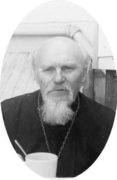
Archpriest Gerasim Shorets. The 1950s. Photo from the archive of the Church of the Intercession of the Most Holy Theotokos of Los Angeles
One other aspect of Fr. Gerasim’s ministry should be specially noted: that of his literary work, which is basically apologetic in nature. He began this work back in the Tobolsk Diocese. In Germany, his writings were published by the Missionary Committee of the Diocese of Germany. His work “Vseobshchaia Tserkovnaia istoriia” [A General Church History], a copy of which is preserved in the AGE (F.6, Op.1, Korobka 6, d.6/5) is of interest for this article. Laying out the history of the Church from the beginning of Christianity, Fr. Gerasim devotes attention to the history of Orthodoxy in Lithuania. According to Fr. Gerasim, Orthodoxy found its way into Lithuania in the tenth and eleventh centuries thanks to Russian missionaries. The development and strengthening of Orthodoxy in Lithuania was enhanced by the population of the southern Russian princedoms that were joined to Lithuania by Grand Dukes Mindaugas, Gediminas, and Algerdis, as well as by dynastic marriages between representatives of the princedoms of Lithuania and Rus’. Orthodoxy was adopted by Lithuanian princes and the ruling elite. He briefly describes the conversion of Mindaugas’ son Vasilvilkas and his efforts to enlighten Lithuania with “the light of Christian truth.” A separate chapter is devoted to the Lithuanian martyrs, Saints Anthony, John, and Eustathius, who were martyred in 1347 during the reign of Prince Algerdis. The persecution and execution of the holy martyrs was a reaction of pagan priests to the spread of Orthodoxy among the Lithuanians. In the chapter entitled “Sviatye Zapadno-Russkoi Tserkvi” [Saints of the Western Russian Church], Fr. Gerasim presents biographies of saints who were born in Lithuania: the Venerable Eupraxia of Pskov (+1243), the Venerable Charitina, Princess of Lithuania (+1281), St. Dovmont (Domant), Timothy of Pskov (+1299), the Venerable Tikhon of Luchov (+1503), St. Juliana Olshanskaya (+1566), and others.
This work was probably written by Fr. Gerasim during the Lithuanian period of his life. This is confirmed by the author’s concluding remarks, which are directed toward a Lithuanian Orthodox reader: “In studying the history of the Christian Church, we see what a great and mighty force the Orthodox Church represents in the history of mankind as a whole and specifically in the life of our people in Lithuania. We cannot help feeling gratitude to God for being members of this Church and must love her even more, learn to follow and imitate the saints who have shone forth in her, and to work unremittingly for her good and prosperity.”[31]Archpriest Gerasim Shorets, Vseobshchaia tserkovnaia istoriia {General Church History], (Munich: Missionerskii komitet Germanskoj eparkhii, 1949), 76.
Archpriest Alexander Chernai
Born in Kaunas, Archpriest Alexander Chernai (1899-1985) was one of Fr. Gerasim Shorets’ co-workers in the Lithuanian Diocese who was evacuated to Germany. He was a graduate of the Vilnius Theological Seminary and started serving in 1925 as a supernumerary deacon at the Cathedral of the Resurrection in Kaunas. After being ordained to the priesthood in the same year by Metropolitan Eleftherios of Vilnius and Lithuania, he was appointed rector of the church in Utena and administrator of the church in Uzpaliai. He was later transferred to the Church of St. Sergius in Vekshniai. In 1944, he was evacuated to Germany, where he ended up in Bad-Neuheim, a resort in the Hesse-Nassau region. In 1945, he set up a Russian Orthodox mission to minister to Russian refugees, and founded churches in the Hanau, Giessen, Arolzena, and Gudensberg DP camps. In September of the same year he was admitted into the ROCOR Diocese of Germany by Metropolitan Seraphim (Liade). What is interesting about Fr. Alexander’s personal file in the AGE (F.2 Op.1, Korobka 1, d.1, ch.34) is that it contains documents relating to his service in the Lithuanian Diocese. Very few clergy were able to take along with them originals or copies of documents from their previous places of service when they evacuated. Among those documents are copies of the following: an announcement by the Lithuanian Diocesan Council dated December 12, 1925 containing a resolution by Metropolitan Eleftherios on the forthcoming ordination of Deacon Alexander Chernai to the priesthood (l.7); his award of the nabedrennik on April 12, 1930 by the same hierarch (l.8), of the skufia on April 20, 1932 (l.9), and of a golden pectoral cross on December 9, 1941 by Metropolitan Sergius (Voskresenskii); his elevation to the rank of archpriest on December 6, 1943; and a copy of canonical release granted to Fr. Alexander by the acting Patriarchal Exarch of Lithuania, Latvia, and Estonia Archbishop Daniel (Yuzviuk) of Kaunas on December 12, 1944 while Archbishop Daniel was in the Friedrichswalde Camp.
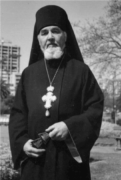
Archimandrite Alexy (Chernai). Photo from the archive of the Church of St. John of Kronstadt in San Diego
The majority of the documents in Fr. Alexander’s file have to do with his service at the Bad-Nauheim Mission. Of particular interest among them is the “Report on the Missionary Activity of Rev. Archpriest Alexander Chernai from February 16 to April 30, 1946” (l.15-16 ob.), and documents relating to the period of Fr. Alexander’s suspension from serving from April 5 to May 14, 1946 with his removal from the clergy of the German Diocese (l. 17-33 ob.). The accusations levelled against Fr. Alexander, including an accusation of his transfer to the Moscow Patriarchate, were not confirmed, except for the creation of the mission in Hesse-Nassau without the blessing of his ruling bishop. Once the circumstances of the matter had been clarified and a discussion held with Metropolitan Seraphim (Liade), his suspension was lifted and he was again included among the clergy of the German diocese. In connection with Fr. Alexander’s suspension, a character reference provided by his former colleague in the Lithuanian Diocese Archpriest Gerasim Shorets is noteworthy. Fr. Alexander himself requested this reference from Fr. Gerasim, including it with his letter to Metropolitan Seraphim (Liade) of May 13, 1946 9 (l.27-27ob.). This is how Fr. Gerasim characterizes Fr. Alexander: “I know Fr. Alexander Chernai very well, as someone who started and continued to perform pastoral work for about ten years in the Panevezis deanery of the Lithuanian Diocese that was under my authority. As secretary to the dean of Kaunas and the acting Patriarchal Exarch, I likewise closely observed the continuing pastoral activity of Fr. Chernai and can testify that he is a kind and diligent pastor who is particularly devoted to the beauty and splendor of God’s churches in the places of his work” (p.28). The history of Fr. Alexander’s work in Germany may also be reconstructed from documents relating to the activity of the mission in Hesse-Nassau (AGE, F.3, Op. 1, Korobka 4, d. 5/4, d.“Vikariatstvo Gross-Hessen, 1946-1947 gody” [The Gross-Hessen Vicariate, 1946-1947]. The items contain basic documents relating to the work of the mission in Hesse-Nassau (minutes of a meeting of the mission’s Board of Directors, reports and addresses on its activity), detailed documentation of the reasons for liquidating the mission, which completely ceased its activity on October 1, 1947. Important documents from the mission have been preserved, including the project “Bylaws of the Orthodox Mission in Hesse-Nassau” and “Regulation on the Order of Participation by the Greek Orthodox of Bad-Nauheim and its Surroundings under the Jurisdiction of the Patriarchate of Constantinople for the Temporary Use and Administration of the ROCOR Russian church in Bad-Nauheim.” After the mission was closed, Fr. Alexander remained as an itinerant priest of the Gross-Hessen Vicariate, and on February 15, 1948 he was released from the Diocese of Germany in connection with his move to America.
Also in Germany were several priests from the Lithuanian Diocese who had served in Central Lithuania and transferred to the jurisdiction of the Moscow Patriarchate from that of Metropolitan Dionisius (Valedinskii)[32]Metropolitan Dionisius (Valedinskii, 1876-1960) of Warsaw and Volyn, was primate of the Polish Orthodox Church in the Patriarchate of Constantinople jurisdiction from 1923 to 1948. In 1948, he sent a … Continue reading on the reunification of Lithuania. These included Archpriests Boris Borisevich and Constantine Kaminskii.
Archpriest Boris Borisevich
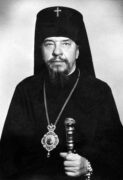
Archbishop Cyprian of Philadelphia and Eastern Pennsylvania
According to his service record and questionnaire, Fr. Boris Borisevich (1903-1980) graduated from the Orthodox Theological Faculty at Warsaw University with a Master’s Degree in Theology. He was ordained to the priesthood in 1928 in the Polish Orthodox Church and served in the Volyn and Grodno Dioceses. On March 17, 1939 he was assigned to the church of the Holy Spirit Monastery in Vilnius by Archbishop Theodosius (Feodosiev) of Vilnius, and then in November of that year Metropolitan Eleftherios accepted him into the Lithuanian Diocese, where his duties remaining the same. In February 1940, he was appointed a supernumerary priest of the Vilnius Cathedral of the Theotokos. Following the ban on religious instruction in Lithuanian schools, he was relieved of his position as Supervisor of Religious Education on July 10, 1940. On April 13, 1942 Exarch Sergius (Voskresenskii) appointed him as sacristan of the Cathedral of the Annunciation in Kaunas. On evacuating from Lithuania in the fall of 1944 he was assigned by Metropolitan Seraphim (Liade) to serve the religious needs of the Orthodox in Linz, Austria, and on August 14, 1945 he was transferred to Augsburg to organize an Orthodox parish. The year 1946 marked the appointment of Fr. Boris as a member of the Council of Bishops and chairman of the Missionary Committee of the Diocese of Germany. He left Germany in the middle of 1949 and served in the Orthodox Church in America. After his wife’s repose he was tonsured as a monk with the name Kiprian and was consecrated as Bishop of Washington, dean of the New York Diocese.
Archpriest Constantine Kaminskii
The materials on Fr. Constantine Kaminskii (1903-1984) mention only his service in the Lithuanian Diocese of the Moscow Patriarchate. In a questionnaire Fr. Constantine completed in 1947, Poland is specified as his previous place of ministry. However, in the column listing ecclesiastic awards there is an entry indicating that he was awarded a pectoral cross in 1940 by Metropolitan Eleftherios. According to this questionnaire, he graduated from the Vilnius Seminary in 1927 and from the Orthodox Theological Faculty of Warsaw University with a Master’s Degree in Theology. He was ordained to the priesthood on October 1, 1935 in Vilnius by Archbishop Theodosius (Feodosiev). We know from other sources that after the annexation of the province of Vilnius to Lithuania in 1939, Fr. Constantine was obliged to leave his parish in the village of Gorbachi (now in the Grodno Diocese of the Moscow Patriarchate in the Belarus Exarchate) and to flee to Svisloch, and then to Vilnius. On September 22, 1939 Fr. Simeon Kaminskii, Fr. Constantine’s father, who had come to Gorbachi to stand in for his son, was brutally murdered.[33]A. A. Kornilov, ”Perepravimsia na tu storonu…“ Deiatel‘nost‘ pravoslavnogo dukhovenstva v lagere peremeshchionnykh lits Shliaisgaim (1945-1951 gg.) [”We Will Cross Over to the Other … Continue reading The length and precise nature of Fr. Constantine‘s service in the Lithuanian Diocese of the Moscow Patriarchate is impossible to determine on the basis of the data in the archive. Light may be shed on Fr. Constantine‘s postwar period in the Schleissheim DP Camp on the basis of materials in the dossier “Khram Arkhistratiga Mikhaila, Shleiskhaim“ [Archangel Michael Church, Schleissheim], (AGE, F. 3.).
Protopresbyter Basil Vinogradov
The diocesan archive also contains files on clergy who had come to Lithuania from Soviet Russia and served briefly in the Baltic Exarchate. These include Protopresbyter Basil Vinogradov and Archpriest John Kharchenko. Fr. Basil Vinogradov (1885-1968) was well-known in ecclesiastical academic circles, having been a teacher and professor at the Moscow Theological Academy and a research fellow of the Russian Historical Museum. Patriarch Tikhon (Belavin) ordained him to the priesthood in 1922. He served in the Moscow Diocese and was chairman of the Diocesan Council. He was repeatedly subjected to arrests and confinement in the Soviet Union.
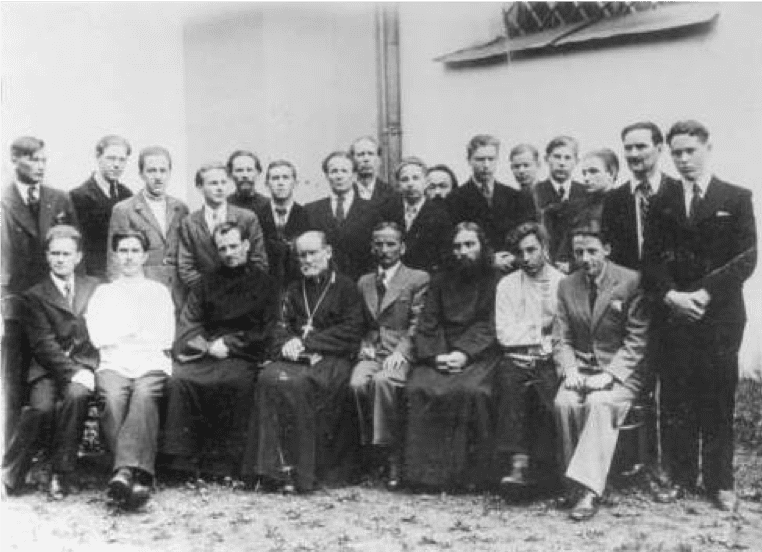
Theological courses 1942–1943 in Vilnius. In the center of the photo, the rector of the courses, protopresbyter Vasily Vinogradov. The third from the right is a student of the course, priest Nikolai Guryanov (1909-2002)
At the beginning of the Second World War, he was serving in the Kaluga Diocese, from which he moved to the Baltic Lands during the German occupation. In 1942, Metropolitan Sergius (Voskresenskii) appointed him as dean of the Monastery of the Holy Spirit in Vilnius and rector of courses in pastoral-theology. He evacuated from Lithuania to Austria in 1944 and then to Germany. From 1945 until his death in 1968, he served in churches of the German Diocese of the ROCOR. In Fr. Basil’s personal file (AGE, F.2, Op.1, Korobka 3, d.3), there is only one document relating to his ministry in Lithuania – the original of Metropolitan Sergius’ (Voskresenskii) decree awarding Fr. Basil the rank of protopresbyter. The AGE documents paint an extensive portrait of his pastoral and teaching activity in Germany (AGE, F.3, d. “Sviato-Nikolaevskaia tserkov’, Shtutgart [St. Nicholas Church, Stuttgart]”; F.3, Op.1, Korobka 5. d.5/4; “Khram Arkhistratiga Mikhaila, Shleishaim [Church of the Archangel Michael, Schleissheim”; F.4, d. 26/12 “Delo o priniatii na sluzhbu prot. Sergeia Matveeva v germanskuiu prav. Eparkhiiu s naznacheniem k tserkvi Arkhangelo-Mikhailovskoi v Liudvisfel’de v pomoshch ottsu protopresviteru Vinogradovu 1956-1957 [The Matter of Receiving Archpriest Sergei Matveev into service in the German Orthodox Diocese with Assignment to the Church of the Archangel Michael in Ludwigsfelde to Assist Protopresbyter Vinogradov 1956-1957].”
Archpriest John Kharchenko
Only two documents in Fr. John Kharchenko’s personal file (1901-1963) (AGE, F.2, Op.1, Korobka 1, d.1, ch.33) relate to his service in Lithuania. The first one, a canonical release from the German Diocese, states that Fr. John came to Germany on June 8, 1944 from the Lithuanian Diocese. His questionnaire regarding the places where he had previously served is more informative. Born in the Don Region, he graduated from the Ardon Theological Seminary and in 1938 from the Economic Planning Institute. On February 12, 1927 he was ordained to the diaconate by Archbishop Peter[34]The question of which bishop ordained Fr. John remains open. From 1919 to 1928 the Tver’ Diocese was occupied by Metropolitan Seraphim (Alexandrov), who was repeatedly arrested by the GPU-OGPU. … Continue reading and served in the Tver’ Diocese until 1941.
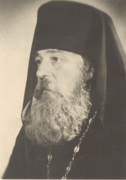
Archimandrite John (Kharchenko). Photo from the archive of the Church of St. Panteleimon in Brussels
In 1943, he was accepted into the Lithuanian Diocese and ordained to the priesthood by Metropolitan Sergius (Voskresenskii). There is no information on how Fr. John came to be in Lithuania in his personal file. Probably, this happened as a result of the German occupation of Kalinin in October 1941. In 1944, he was appointed a missionary of the Lithuanian Internal Mission, a fact confirmed by the historian K. P. Oboznii in his work Istoriia Pskovskoi Pravoslavnoi Missii, 1841-1944 gg.,[35]K. P. Oboznii, Istoriia Pskovskoi Pravoslavnoi Missii 1941-1944 gg. [History of the Pskov Orthodox Mission, 1941-1944], (Moscow: Izd-vo Krutitskogo podvor’ia i Obshchestva liubitelei tserkovnoi … Continue reading where he states that Fr. John’s last posting in Lithuania was the parish in Skuodase. According to the memoirs of Fr. Alexander Chernai, Fr. John was his concelebrant at the church in Vekshiai, to which the parish of Skuodase was attached.[36]Archimandrite Alexis Chernai, Zhiznennyi put’ russkogo sviashchennika [The Life’s Journey of a Russian Priest], (San Francisco: Globus), 198?, http://ricolor.org/historypv/45/. He was admitted to the German Diocese in December 1945. In May 1948, he emigrated to Belgium, where he joined the jurisdiction of the Russian Orthodox Churches in Western Europe under the Patriarchate of Constantinople. On becoming a widower, he accepted monasticism and reposed in Brussels as an archimandrite.
Priest Boris Cherepovich
Fr. Boris Cherepovich (1903-?) emigrated from Lithuania and was among the evacuated Balts who were ordained to the priesthood in Germany. According to documents in the AGE, Fr. Boris lived in Ravensburg as a subdeacon (AGE, F.2, Op.3, Korobka 15, d.15/14). His personal file contains the ordination of Subdeacon Boris to the diaconate by Metropolitan Seraphim (Liade) on November 16, 1947, together with an assignment as a supernumerary deacon to the Church of the Holy Cross in Zaulgau. According to the archival documents, Fr. Boris was a graduate of the Kostroma Theological Seminary, and in Lithuania he graduated from the Kaunas Russian Grammar School and the Technical Department of the University of Lithuania. He emigrated to America in 1949 as a deacon. Later on, he was ordained to the priesthood and served for a while at the Church of the Holy Protection in Los Angeles, which had been founded by Fr. Gerasim Shorets.
Concluding this overview of the archival documents dealing with Lithuania, the limitations of the data on the Lithuanian Orthodox diaspora in Germany should be noted. It is difficult to judge how the absence of a Lithuanian Orthodox administrative center in Germany, that is of a bishop of the Lithuanian Diocese or a clergyman of that diocese who could have created something resembling such a center affected the spiritual care of Orthodox Lithuanians in Germany. It should be noted, however, that Orthodox Lithuanians in Germany adapted successfully to church communities in the ROCOR or to Estonian and Latvian parishes. The percentage of Orthodox was not large among ethnic Lithuanians, so it is perfectly understandable why, having joined the German Diocese, former clergy from Lithuania did not undertake any attempts to minister exclusively to their former compatriots.
Latvia
Priest George Freimanis
Metropolitan Augustins (Petersons) of Latvia evacuated in September 1944 to Germany. He was forced to move about a good deal all over Germany before ending up at the final spot of his earthly sanctuary, a sanatorium in Gauting, a suburb of Munich. In October 1945, he moved from Potsdam to the Lithuanian Dobbenteich Camp in Oldenburg. Two interesting documents in the archive come from this period, which present the view of individual figures from the ROCOR towards further relations with the EAOC and the LOC. These are letters from Archimandrite Nathaniel (Lvov) [37]Archbishop Nathaniel (Lvov, 1906-1986) was assistant abbot of the Monastery of St. Job of Pochaev in Ladomirov during the Second World War. In 1945, he was appointed rector of the Cathedral of the … Continue reading to Metropolitan Seraphim (Liade) (AGE Fr.3, Op.5, Korobka 55, d.55/1). In a letter dated December 11, 1945 Fr. Nathaniel mentions a Latvian novice named George Freiman (Freimanis),[38]The priest George Freiman (Freimanis) (September 28, 1895-?) served in the LOC in the emigration. He was born in Liepaja to a German Lutheran family. He graduated from the Commercial Institute in … Continue reading with whom they discussed the idea of uniting all of the Orthodox bishops who did not recognize the Moscow Patriarchate into the Church Abroad, which for its part would admit representatives of the Orthodox diaspora living outside the boundaries of their prior jurisdictions. The ROCOR was given a leading role in these plans. It was presumed that the EAOC and the LOC would enter into this Church, on which subject, according to Fr, Nathaniel, George Freimanis was in no doubt. In a letter from the same author to Metropolitan Seraphim dated December 13, 1945 it follows that George Freimanis made efforts regarding negotiations on uniting the EAOC and the LOC with the blessing of Metropolitan Seraphim (Liade). Other documents confirming to what extent this information corresponds with reality have not yet come to light.
This period, i. e. December 1945, was also the time of letters sent by the head of the LOC to Metropolitan Seraphim (Liade), which testify to the nature of the relationship between Metropolitan Augustins and the ROCOR. They have been preserved in the personal file of the above-mentioned George Freimanis (AGE, F.2, Op.1, Korobka 1, ch.31). The reason for Metropolitan Augustins’ letters to the head of the German Diocese was his request that George Freimanis be ordained for the spiritual care “of Latvian refugees scattered throughout Germany in those cities and villages where there are no Orthodox clergy who know Latvian” (letter dated December 8, 1945, sheet 2, reverse). Suffering from acute tuberculosis, Metropolitan Augustins was himself placed in the infirmary at the Baltic camp in Hana (a suburb of Oldenburg). The letters by Metropolitan Augustins, which were written at the same time as those written by Archimandrite Nathaniel and were given to Metropolitan Seraphim by the same George Freimainis, do not make any mention of the idea of creating an Orthodox Church Abroad or conducting negotiations regarding the issue of the Baltic Churches entering the ROCOR. Nonetheless, they do allow us to discern Metropolitan Augustins’ position regarding the future of the LOC. Characterizing the situation in Latvia in the first half of the forties, he writes: “It will be difficult for the Latvian Orthodox Church to be strengthened anew and attain the well-being that it had in 1940. But if Latvia is free, and I hope and believe that will be the case, the Great Hierarch will preserve Orthodoxy in Latvia. I am now addressing Your Preeminence with a humble request to preserve what may still be preserved for the future of Orthodoxy in Latvia” (letter dated December 8, 1945, sheet 2-2 reverse). This is followed by a request to ordain George Freimanis as a priest of the Cathedral of the Nativity of Christ in Riga with a temporary assignment to any church of the German Diocese. As a supplement to this letter, Metropolitan Augustins wrote another letter to Metropolitan Seraphim on December 10, 1945 that also concerned the future of the LOC: “My heart and head are troubled by two questions only – what will become of Latvia and what will become of the Latvian Orthodox Church?” (letter dated December 10, 1945, sheets 3, reverse – 4). Besides his illness and age-related infirmity, Metropolitan Augustins had practically no Latvian clergy at his disposal by that time. With George Freimanis’ ordination, an opportunity appeared of preserving and developing the LOC in Germany.
The letters also contain information that Metropolitan Seraphim provided financial aid to Metropolitan Augustins, which was very much needed. He likewise fulfilled his request to ordain George Freimanis. Bishop Stephen (Sevbo)[39]Archbishop Stephen (Sevbo, 1872-1965) was consecrated on May 17, 1942 as Bishop of Smolensk and Bryansk of the Belarusian Metropolitanate of the Moscow Patriarchate. He evacuated to Germany in 1944 … Continue reading ordained him as a priest at the Church of the Holy Resurrection in Munich-Freimann. Information about Fr. George ceases with his ordination, and it is currently not known how long he served under Metropolitan Augustins. He soon moved to London.
Various clergy
On the whole, the problem of ministering to Latvian believers in Germany was rather complicated for the LOC. After evacuating to Germany, a portion of the Latvian clergy joined the ROCOR and was assigned to parishes. These included Fr. George Benigsen, Frs. Victor and Arsenius Kolibersky, Fr. Eugene Lyzlov, Fr. Theodore Mikhailov, and Fr. Alexander Dribintsev. A group with Bishop John (Garklavs) came from Czechoslovakia as late as in August 1945 to Amberg in Bavaria (in the American occupational zone). Besides Bishop John, this group included Fr. Nicholas Perekhvalskii, Fr. John Baumanis, Fr. John Legkii, Fr. Leonid Ladinskii, and Fr. Nicholas Vieglais. Fr. John Legkii transferred to the ROCOR jurisdiction as early as September 1945. At the same time, Fr. Michael Zelnerenok, who had evacuated to Germany before the other Latvian priests, joined Bishop John, whose group had arrived in Germany, and ceased to commemorate the ROCOR primate Metropolitan Anastasii and Metropolitan Seraphim, head of the German Diocese, whose authority he had acknowledged up till then. Later, as a result of the ordination of Peter Kurzemnieks to the priesthood, Bishop John’s group obtained yet another priest. Individual Latvian priests, Fr. John Molotok, Fr. John Briedis, Fr. John Liepins, and Fr. Vladimir Skilnis, collaborated with Metropolitan Augustins, while under the aegis of the German Diocese. But this was not a permanent situation.
The personal files of the Latvian clergy serve as the main sources for research on the history of the German period of the LOC (since 1946 the LOC in the Emigration). Naturally, these personal files were created only for the priests who transferred to the ROCOR jurisdiction or who temporarily functioned under the aegis of the German Diocese. Fond 2 of the AGE contains the personal files of the following Latvian priests:
Archpriest George Benigsen AGE, F.2, Op.1, Korobka 2, d.2/6.
Archpriest John Legkii AGE, F. 2, Op.1, Korobka 6, d.6/6.
Archpriest Victor Kolibersky, AGE, F.2, Op.1, Korobka 5, d.5/14.
Priest Arsenii Kolibersky, AGE, F.2, Op.1, Korobka 5, d.5/13.
Priest John Molotok, AGE, F.2, Op.1, Korobka 7, d. 7/15.
Priest John Liepins, AGE, F.2, Op.1, Korobka 6, d. 6/7.P
Archpriest John Briedis, AGE, F.2, Op.1, Korobka 1, d.1, ch.4.
Priest Vladimir Skilnis, AGE, F.2, Op.1, Korobka 13, d.13/11.
Archpriest Theodore Mikhailov, AGE, F.2, Op.1, Korobka 7, d.7/10.
Archpriest Eugene Lyzlov, AGE, F.2, Op.1, Korobka 1, d.1, ch.19.
Priest Alexander Dribintsev, AGE, F.2, Op.1, Korobka 1, d.1, ch.10
Priest George Freimanis, AGE, F.2, Op.1, Korobka 1, d.1, ch.31
The files of certain priests should be examined in detail, since they contain important information on the situation of the spiritual care of the Latvian Orthodox community in Germany and enhance the study of the complex jurisdictional situation of the LOC.
Metropolitan Augustins (Petersons), Bishop John (Garklavs), Priest John Molotok
One of the most significant events in the history of the LOC in Germany, the lifting on September 39, 1946 by the Synod of Bishops of the ROCOR of the suspension imposed upon Metropolitan Augustins by the Exarch of the Baltic Lands Metropolitan Sergius (Voskresenskii) on June 15, 1942, is not recorded in the Archives of the German Diocese. Since this matter was handled by the Synod of the Russian Church Abroad, which was in Munich, the documents were placed in the archives of the Synod of Bishops of the ROCOR.[40]The documents in the archives of the ROCOR Synod of Bishops on this subject have been published in full in A. V. Gavrilin, ”Dokumenty po delu mitropolita Rizhskogo i vseia Latvii Avgustina … Continue reading An event that followed this, the signature on October 20, 1946 of a statement by Metropolitan Augustins (Petersons) and Bishop John (Garklavs) on working together to organize the LOC in the Emigration, was reflected in the AGE documents only indirectly in the files of individual priests, basically as a reaction to this event. Notwithstanding, only in the file of Fr. John Molotok[41]John Molotok (August 28, 1915-?) was born in the Piedruja district of the province of Vitebsk. In 1933, he graduated from the Belarusian State Grammar School in Dvinsk and the Theological Department … Continue reading is a copy of this statement preserved in Latvian, together with a translation into Russian in the handwriting of Fr. John Liepins‘[42]Archpriest John Liepins (February 13, 1900-1986) graduated from the Riga Theological Seminary in 1933. On July 1, 1934 he was ordained to the priesthood by Archbishop John (Pommer) of Riga and All … Continue reading (AGE, F.2, Op.1, Korobka 7, d. 7/15, l.41-42 ob.). The purpose of the agreement between the Latvian hierarchs was to unite all of the Latvian Orthodox in Germany into one organization, the LOC in the Emigration, which would function as an autonomous church structure. Prayer relations were restored with Metropolitan Augustins (p.2), and he took upon himself the leadership of the LOC in the Emigration. Bishop John was to take Metropolitan Augustins‘ place in case of illness, or if circumstances prevented him from fulfilling his duties in administering the Church. A Synod of the LOC in the Emigration was established, which included both hierarchs, three priests, and three laymen. The LOC in the Emigration was obliged to adhere to the bylaws of the LOC (p. 8).
In reality, the LOC in the Emigration was led by Bishop John (Garklavs), since Metropolitan Augustins was constantly undergoing treatment in sanatoria. In spite of the fact that the Synod was actively involved in setting up the internal life of the LOC, Bishop John’s name appears quite rarely in the AGE documents, and mainly in connection with taking the Tikhvin icon of the Mother of God, whose guardian he was, to churches of the German Diocese (for instance, AGE, “Letter of Archpriest Nicholas Sherotskii to Metropolitan Seraphim (Liade)” of October 16, 1948). He maintained a formal relationship with ROCOR representatives, addressing the head of the German Diocese when necessary (AGE, “Letter of Bishop John (Garklavs) of Riga to Metropolitan Seraphim (Liade) of March 23, 1949 with a Request to Provide 4 antimensia for the Needs of the LOC in the Emigration”).
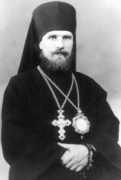
Bishop John (Garklavs)
Relations between Bishop John and Metropolitan Augustins, who had been forced into joining up with Bishop John to create the LOC in the Emigration, were complicated, for “he did not regard him, as someone who had been consecrated by hierarchs of the Moscow Patriarchate, to be a legitimate hierarch.”[43]Gavrilin, op. cit., 101. Metropolitan Augustins saw the future of the LOC in the Emigration in the jurisdiction of the Patriarchate of Constantinople, which he had already started working towards in the spring of 1947, when he made an appeal to Metropolitan Germanos (Strenopoulos).[44]Metropolitan Germanos (Strenopoulos, 1872-1951) was the head of the Thyatira Metropolitanate with its center in London from 1922 and the Patriarchal Exarch in Central and Western Europe. On February … Continue reading In 1948, the Synod of the Patriarchate of Constantinople accepted the Orthodox Latvians of Germany into its jurisdiction. Bishop John, who was unwilling to serve in the Patriarchate of Constantinople, appealed on October 1, 1947 to Metropolitan Theophilus (Pashkovskii) [45]Metropolitan Theophilus (1874-1950) was Metropolitan of All America and Canada from 1934. of All America and Canada with a request for assistance in resettling Latvian clergy to America with their reception into the ranks of the clergy of the American Orthodox Metropolia. A good will gesture on the part of Bishop John, expressed in reconciliation with Metropolitan Augustins, was not accorded its proper value by the head of the LOC. As a whole, the events of 1946, which were intended to normalize the situation of the Latvian clergy, complicated it even more.
It should be noted that as a result of the creation of the LOC in the Emigration, Metropolitan Augustins lost his authority among his own supporters as well. This is demonstrated by a letter from Fr. John Liepins to Metropolitan Seraphim (Liade): “As a result of the actions of His Preeminence Metropolitan Augustins, Orthodox Latvians outside Latvia, particularly in Esslingen, are forced to acknowledge that they find themselves in a position of orphans. They are without a legitimate pastor, since they cannot recognize Bishop John Garklavs, a protégé and representative of the Soviet Church; their conscience does not allow this. As a result, in view of the situation which has been created, they regard it as possible and canonically correct for their priests to seek the patronage and defense of the ruling archpastor of the German Orthodox Diocese in whose jurisdiction God has ordained them temporarily to abide” (October 10, 1948, AGE, F.2, Op.1, Korobka 7, d.7/15, l.37-38 ob.).
The parish in Esslingen was one of the largest Latvian Orthodox parishes in Germany. According to Fr. John Molotok, there were 6,000 Latvians in Esslingen in May 1946, 268 of whom were Orthodox (AGE, F.3, d. “Esslingen, Church of the Holy Resurrection, l.10”). The administration of the Latvian community in Esslingen invited Fr. John Molotok to their parish in 1945, and with Metropolitan Augustins’ blessing he started ministering to Orthodox Latvians. He had the permission of Metropolitan Seraphim (Liade) to serve in churches of the German Diocese from November 6, 1944. However, on February 28, 1946 he again appealed to Metropolitan Seraphim with a request to appoint him as priest for the Orthodox in Esslingen. Probably as a result of a negative attitude towards the fact of the creation of the LOC in the Emigration, Fr. John soon vacated the position of rector of the Esslingen parish. Fr. John’s letter to Metropolitan Seraphim (Liade) of November 12, 1948 shows a lack of recognition of the agreement creating the LOC in the Emigration: “… after my categorical refusal to follow the path of lawlessness, upon which Metropolitan Augustins embarked in 1946 at the instigation of the priests J. Liepins, G. Freiman, J. Briedis, and Stilin (Stilins), I was deprived of everything that it was possible to deprive me of. As regards the administration of the so-called Latvian Church, I have had nothing to do with it since 1940, from the moment of its transfer to the Soviet Jurisdiction (AGE, F.2, Op.1, Korobka 7, d.7/15, l.31. In spite of Fr. John’s wish to disassociate himself from the LOC and its leadership, it was precisely with the blessing of Metropolitan Augustins that he began his activity in Esslingen in 1945. His description of the position of the priests named in the letter with respect to the events of 1946 is incorrect. Fr. John Liepins’ letter, demonstrating his negative attitude towards the agreement between Metropolitan Augustins and Bishop John, has already been quoted above.
Archpriest John Briedis
At the end of July 1946, Metropolitan Augustins moved from the British zone of Germany to Felbach, a suburb of Stuttgart in the American zone. In August 1946, he appointed Fr. John Briedis[46]John Briedis (December 4, 1914-September 15, 1948) was a priest in the LOC (LOC in the Emigration). From 1935 to1936 he served at the Monastery of the Holy Spirit in Ekabspil (?). From 1942 to 1943 … Continue reading to the parish in Esslingen. On August 23, 1946 Metropolitan Augustins issued a decree appointing Fr. John as dean of the American and French zones of Germany and charged him with the administration of the Orthodox Latvian DP camps (AGE, F.2, Op.1, Korobka 1, d.1, ch.4, l.7-8). Somewhat earlier, on June 3, 1946 Fr. John received permission from Metropolitan Seraphim to minister to Orthodox Latvians in those DP camps where there was no permanent priest of the German Diocese. Fr. John‘s health, undermined by being in Buchenwald, meant he could not guarantee regular service at the parish in Esslingen, which caused Metropolitan Augustins to assign Fr. John Liepins, who was living in Weissenburg, to Esslingen in the fall of 1946. Owing to worsening financial circumstances because of the 1948 financial reforms, the trips from Weissenburg to Esslingen became unfeasible for Fr. John Liepins and the parish. By then, Fr. John Brideis’ health had improved and he continued serving in Esslingen. We know that, while being treated at the sanatorium in Bad Kohlgrub, Metropolitan Seraphim (Liade) charged Fr. John Briedis on May 26, 1947 with the temporary performance of the duties of rector of the local church of St. George at the request of its parishioners.
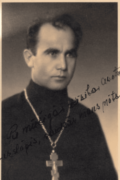
Archpriest John Briedis
Clearly, the Rev. Dean John Briedis’ contacts with Metropolitan Augustins were minimal, as it was not until 1948 that Fr. John found out about the actual situation in the LOC following the signing of the agreement of October 20, 1946. In his letter to Metropolitan Seraphim (Liade), he not only criticizes the agreement of the Latvian hierarchs regarding the creation of the LOC in the Emigration, but also states that “this was all done in secret, without discussion by all the parties concerned, based on the circumstance that the overwhelming majority of the members of the Latvian Orthodox Church have never recognized, do not recognize, and henceforth under no circumstances intend to submit to this agreement and to the Soviet jurisdiction headed by Bishop John of Riga” (letter of September 9, 1948, back of sheet 2). This letter demonstrates that Fr. John Briedis was of one mind with Fathers Molotok and Liepins on this issue. In early September 1948, Fr. John Briedis appealed to Metropolitan Seraphim (Liade) with a request that he take under his wing members of the Latvian clergy and laity who did not support the union of Metropolitan Augustins with Bishop John, and for he himself to be appointed rector of the Esslingen Church. According to Fr. John, Esslingen was ”the center of religious and national culture in the emigration” (reverse of sheet 3). Taking into account this circumstance, as well as the increased number of Orthodox Latvians in Esslingen (370 in total), Fr. John insisted that a specifically Latvian priest was needed to minister to this community. Fr. John was prepared to minister to Russian DPs as well. Fr. John Liepins also appealed on September 9, 1948 to Metropolitan Seraphim (Liade) with a petition to be taken under his jurisdiction (AGE, F.2, Op.1, Korobka 6, d.6/7, l.6-7) . A decree of September 13, 1948 by Metropolitan Seraphim (Liade) accepted Fr. John Briedis into the German Diocese and appointed him as rector of the Esslingen church. Two days later, however, on September 15, 1948, a tragic road accident ended Fr. John’s life.
Frs. John Liepins and Vladimir Skilins
On September 22, 1948 Fr. John Liepins was admitted into the German Diocese and charged with the provision of spiritual care for the Latvians of Esslingen and surrounding towns. The dean of the Latvian parishes in the British zone, Fr. Skilins,[47]Vladimir Skilins (April 25, 1902-?) was a clergyman in the LOC. He was born to a Latvian family that had converted to Orthodoxy in 1845. He graduated from the Riga Theological Seminary and the … Continue reading also tried to take part in setting up a Latvian deanery in the American and French zones. On October 27, 1948 he wrote a letter to Metropolitan Seraphim (Liade) expressing gratitude for accepting Latvian priests under his aegis and stating his wish for the appointment of Fr. John Liepins as dean of the Latvian parishes in the American and French zones, in the place of the deceased Fr. John Briedis (AGE, F.2, Op.1, Korobka 6, d.6/7, l.1-3).
It is clear that Metropolitan Augustins was losing his influence in the largest Latvian center in Germany. At that time, he called the Esslingen parish autocephalous. Esslingen‘s parish council did not even regard it necessary to inform Metropolitan Augustins of the death of the dean, Fr. John Briedis. Rejecting the accusation of the “autocephalous“ nature of the Esslingen parish, Fr. John Liepins pointed out that the parish was under the aegis of the German Diocese (AGE, F.2, Op.1, Korobka 7, d.7/15, l.38).
Metropolitan Augustins’ contacts with the Latvian parishes in the British zone were even shakier. Fr. Vladimir Skilins was in charge of these parishes. On December 9, 1944 he received permission from Metropolitan Seraphim (Liade) to provide spiritual care to Orthodox Latvians. It was only in 1946 that Fr. Vladimir found out Metropolitan Augustins’ address and informed him that his choice of jurisdiction was with the German Diocese (AGE, F.2, Op.1, Korobka 13. D.13/11, l.8). Metropolitan Augustins, on the other hand, continued to regard Fr. Vladimir as “his priest,” expressing gratitude to him for his labors and appointing him to membership in the newly founded Synod of the LOC in the Emigration. Fr. Vladimir called the order he had received an illegal document. He regarded the LOC Synod itself to be illegal. Fr. Vladimir had no desire to clear up his relationship with the ailing Metropolitan Augustins, and he continued providing spiritual care to the Latvian DP camps, considering himself to be in the North German Vicariate of the German Diocese. In the fall of 1948, Fr. Vladimir Skilins was providing spiritual care for Orthodox Latvians in twenty DP camps. In 1947, he received help organizing worship in the DP camps from Anthony Gramotyns,[48]Anthony Gramotyns was a priest of the LOC (LOC in the Emigration). He was born to an Orthodox Latvian family, and was an officer of the Russian army, a participant in the First World War and in the … Continue reading who fulfilled the duties of a reader and organized singing in Latvian. At the request of Metropolitan Augustins, the assistant head of the German Diocese, Bishop Afanasii (Martos) of Hamburg[49]Archbishop Afanasii (Martos, 1904-1983) was consecrated in 1942 as Bishop of Vitebsk. In June 1944, he left the USSR along with the Belarusian episcopate. He joined the ROCOR in 1946 and was … Continue reading ordained Anthony Gramotyns to the diaconate on July 21, 1947 and to the priesthood on July 28, 1947. Fr. Anthony’s personal file (AGE, F.2, Op.1, d.3/13) only contains documents dealing with his ordination, and does not allow us to trace his further path as a priest.
Fr. Vladimir’s own canonical situation soon became unstable. A letter from Metropolitan Seraphim (Liade) to Bishop Afanasii (Martos) of January 24, 1950 mentions that Metropolitan Augustins had suspended Fr. Vladimir (AGE, F.3, Op.5, Korobka 55, d.55/1). This letter is interesting in terms of how the head of the German Diocese characterizes the attitude of Metropolitan Augustins to canonical issues: “As for Fr. Skilins’ suspension, it is not clear from Metropolitan Augustins’ letters for what crimes he has been punished. I should note that Metropolitan Augustins himself is not particular about the canons, for he received one of our clergymen, whom we had ordained, into his jurisdiction without the required canonical release.” That priest was Fr. Dionisius Ilyin, who will be discussed later. The administration of the German Diocese also clarified the canonical situation of Fr. Vladimir, whose documents in his personal file deal essentially only with this issue. Apparently, secular organizations supervising religious issues were also informed of Fr. Vladimir’s suspension. This is indicated in a letter from Fr. Vladimir to Bishop Afanasii (Martos) of January 29, 1950: ”After receiving the letter from Lemgo that my name has been removed from the list of clergymen because Augustins had requested this, and that Your Preeminence does not recognize me either, I no longer dare to serve, while the Latvian parish has been without help for a long time already” (AGE, F.2, Op.1, Korobka 13. D.13/11, l.8 ob.). No documents have been discovered regarding which jurisdiction Fr. Vladmir was under, either in the lists of clergymen of the German Diocese or in the archive of the North German Vicariate. Metropolitan Seraphim testified that he had himself personally permitted Fr. Vladimir to serve in churches of the diocese with the consent of local rectors and assumed that, during Archimandrite Nathaniel’s tenure as administrator in North Germany, Fr. Vladimir could have been appointed to a parish even as rector (AGE, F.3, Op.5, Korobka 55, d.55/1). A document which might possibly shed light upon Fr. Vladimir’s further activity indicates that the situation was not resolved in a positive manner. It is a notification of a service conducted by Ukrainian autocephalists at the Farel Camp in August 1950 (AGE, F.2, O[.1, Korobka 13, d.13/11, l.3). The service was to be conducted in Latvian and Ukrainian, and it was conducted by the priest Vladimir “of the jurisdiction of Metropolitan Policarp (Sikorsky) of the Ukrainian Orthodox Autocephalous Church.” The document in the German Diocesan administration is annotated, “Message from Archpriest Tsukanov,” “Vladimir Skilins.” Additional documents confirming Fr. Vladimir’s transfer to the Ukrainian Apostolic Orthodox Church have not been discovered in the archive.
Archpriest Dionisius Ilyin
In 1949 Bishop John (Garklavs) left Germany, and Fr. Nicholas Perekhvalskii and Fr. Nicholas Vieglais left for America. Fr. John Baumanis had left for Venezuela earlier, in 1947. With Bishop John’s departure, the LOC Synod ceased to exist. Archpriest Leonid Ladinskii, who stayed in Germany, was appointed by Bishop John to be the administrator of the LOC in Germany and Fr. Peter Kurzmenieks as his deputy. Documents have been preserved in the matter “Svedeniia o prikhodah, 1950 g. [Information on Parishes 1950]” (AGE, F.3, Op.5, Korobka 58, d.58/2), which describe the final stage of the LOC administration in Germany. This can be found in a letter of Fr. Leonid to Metropolitan Seraphim (Liade) of March 28, 1950 listing the inventory of the liquidated church of the Latvian camp in Würzburg. The letter also mentions that the inventory of the Latvian churches in Karlsruhe, Ulm, and Ansbach had been handed over to local rectors of the parishes of the German Diocese. In addition, the response of Metropolitan Seraphim (Liade) of April 1, 1950 to Fr. Leonid, expressing gratitude for handing over church property to the German Diocese, has been preserved, as well as a few letters from Archpriest Basil Saltovets, Dean of Würtemberg-Baden, regarding the performance of services in the church at the Latvian camp in Karlsruhe. In the spring of 1950, Fr. Leonid Ladinskii and Fr. Peter Kurzemnieks moved to America.
After 1950, Fr. Dionisius Ilyin was the only priest who was left at Metropolitan Augustins’ disposal in Germany. No documents have been discovered in the archive confirming Fr. Dionisius’ transfer to Metropolitan Augustins’ jurisdiction, with the exception of the letter already cited from Metropolitan Seraphim (Liade) of January 24, 1950 to Bishop Afanasii (Martos) (AGE, F.3, Op.5, Korobka 55, d.55/1). Letters from Fr. Dionisius preserved in the diocesan correspondence for 1950-1954 (AGE, F.7, D. “Eparkhial’naia perepiska”) speak of his close relationship with the German Diocese. He sent the parish ledgers and records of church financial transactions to the diocesan administration. The leadership of the German Diocese assigned him to serve diocesan parishes, and his renumeration was paid out from the diocesan treasury and by Metropolitan Augustins. In March 1951, Fr. Dionisius, on the basis that he was being renumerated by the head of the LOC, was removed from the list of clergy renumerated from the diocesan treasury. It was noted, notwithstanding, that Fr. Dionisius served the flock of the German Diocese to a greater extent than he served the Orthodox Latvians.
Fr. Dionisius’ letters are interesting for their information about Esslingen, the former Latvian center of Germany, whose Orthodox parish he took charge of in 1949. In November 1950, he reported the following to Archbishop Benedict of Berlin and Germany: “My Orthodox community in Esslingen is almost entirely gone. Part of it has been transferred to Ulm, part of it to Schwabisch-Gmünd, and part to Bad Cannstatt outside Stuttgart. At the Divine Liturgy last Sunday, the 5th of November, there were eight people in church. There is neither a reader nor a choir. Everyone is gone” (AGE, F.7, D. “Eparkhial’naia perepiska, 1951 god”). In 1952, two or three people would attend daily services in Esslingen during the first week of Great Lent. Fr. Dionisius’ biography has been preserved in his file (AGE, F.2, Op.1, Korobka 5, d.5/2). He was born in 1882 in the province of Mogilev. From 1900 to 1910 he lived in St. Petersburg, where he worked in the railroad administration. In 1910, he was transferred to Riga, and at the start of the First World he was evacuated to Vitebsk. In 1915, he was appointed an official of the railroad administration at the headquarters of the Commander-in-Chief in Mogilev. In March 1918, he fled to Riga. From 1930 to 1933, he studied at the Riga Theological Seminary. From 1927 to 1930, he was reader at the Riga Cathedral, and from 1930 to 1935 at the Annunciation Church in Riga under its rector Archpriest Alexander Makedonskii. He moved to Berlin in 1938. He was ordained to the diaconate and priesthood in May 1939 by Bishop Seraphim (Liade) of Berlin and Germany and served in Marienbad, Franzensbad, and Karlsbad. In 1942 he was arrested by the Gestapo, sent to a concentration camp, and released from Dachau on May 3, 1945. He lived in Marienbad from 1945 to 1949 and then in Germany. These facts help us to understand Metropolitan Seraphim’s rebuke of Metropolitan Augustins, coming as it did from the person who had ordained Fr. Dionisius to the priesthood. However, the Latvian period of Fr. Dionisius’ life, including his life in the church, predetermined his ministry to Orthodox Latvians in Germany. When Fr. Dionisius reposed on April 12, 1954 Metropolitan Augustins was left in total isolation.
Earlier on, Metropolitan Augustins had made attempts to summon Latvian émigré priests to Germany to minister to Orthodox Latvians, but that had brought no results. This is demonstrated especially by documents in the diocesan correspondence during 1954, which mention Metropolitan Augustins’ invitation of Fr. Vladimir Tolstoukhov[50]Vladimir Tolstoukhov (1914-?) was a former clergyman of the LOC, the Latvian diocese of the Moscow Patriarchate, the ROCOR, and the Western European Exarchate of Russian Parishes under the … Continue reading. It was in Germany, where Fr. Vladimir arrived on December 1, 1953, that his canonical situation was discovered, which was his suspension and defrocking by Metropolitan Vladimir (Tikhonitskii). [51]Metropolitan Vladimir (Tikhonitskii, 1873-1959) ruled the Western European Exarchate of Russian Parishes under the Patriarchate of Constantinople from March 6, 1947 (de facto from August of 1946) … Continue reading from France.
On April 7, 1955, due to a worsening of his illness, Metropolitan Augustins handed over the care of the LOC and Orthodox Latvians in Germany to Archbishop Alexander (Lovchii) of Berlin and Germany. This event is described in a separate AGE file (F.4, “Delo of poruchenii Vysokopreosviashcheneishem Avgustinom, Mitropolitom Latviiskim Arkhiepiskopu Berlinskomu i Germanskomu okormleniia pravoslavnykh latviitsev I popecheniia o Latviiskoi Pravoslavnoi Tserkvi v Germanii.”). In particular, it contains the original of Metropolitan Augustins’ statement to Archbishop Alexander of April 7, 1955, Archbishop Alexander’s circular to the clergy of the German Diocese (the only known document at the diocesan level publicizing the actions undertaken by the head of the German Diocese with respect to the LOC parishes), and an act signed by witnesses to Metropolitan Augustins’ request to Metropolitan Alexander that he take the faithful of the Latvian Church under his care. Materials from diocesan correspondence for 1954 through 1958 supplement the documental base regarding the transfer of care for the LOC. This may be found in the correspondence between Archbishop Alexander (Lovchii) of Berlin and Germany and Metropolitan Anastasius (Gribanovskii),[52]Metropolitan Anastasius (Gribanovskii, 1873-1965) was the First-Hierarch of the ROCOR from 1936 to 1964 and head of the Bishops’ Council and Synod. He retired in 1964. which took place in parallel to the talks of the head of the German Diocese with Metropolitan Augustins. All of the AGE material dedicated to the process of transferring the care for the LOC to the head of the German Diocese of the ROCOR was published in Pravoslavie v Baltii, no. 2 (2014).
In spite of Metropolitan Augustins being under the Patriarchate of Constantinople (for a second time from 1948), the transfer of the care for the LOC to the German Diocese of the ROCOR represents a natural and timely process. From the moment prisoners of war and refugees from the USSR appeared in Germany, the German Diocese of the ROCOR took on the responsibility for their spiritual care and bore this burden until the liquidation of the last camps in Germany. In the complex circumstances of displacement throughout Germany and beyond its borders of hundreds of thousands of former Soviet citizens, the ROCOR was able to organize and arrange church life in the DP camps, provide support for the needy, save people from repatriation to the Soviet Union, and assist those wanting to move from Germany to other countries. By sealing the process with an official act, Metropolitan Augustins was guaranteeing protection by the German Diocese for his former compatriots.
Archpriest Emmanuel Essenskii
To conclude the Latvian section of this article, special mention ought to be made of documents in the personal file of a priest of the German Diocese whose fate was also linked to Latvia: Fr. Emmanuel Essenskii (AGE, F.2, Op.1, Korobka 4, d.4/1). Fr. Emmanuel was born in 1907 in St. Petersburg. In the first year of the Revolution, his family moved to Riga. With the blessing of Archbishop John (Pommer), he enrolled in the Riga Theological Seminary, from which he graduated in 1930. After graduation, he was recommended to continue his studies at the St. Sergius Institute in Paris, which he attended from 1930 to 1932. In 1932, Metropolitan Evlogii ordained him as a celibate to the diaconate and priesthood. In accordance with his canonical release from the German Diocese (l.1), he was in the AS ROCOR jurisdiction from 1937. He began his service in Germany in the jurisdiction of the head of the Western European Exarchate of the Patriarchate of Constantinople, Metropolitan Evlogii serving at the Church of St. Vladimir in Berlin and the Memorial Church of St. Alexis in Leipzig. While in the ROCOR, he served at the Berlin Cathedral and in Goslar from 1945, where the parish was in the North German Vicariate. Metropolitan Seraphim (Liade) elevated Fr. Emmanuel to the rank of archpriest. In 1947, he was a member of the Council of Bishops of the German Diocese. There are no historical sources indicating Fr. Emmanuel’s connection with Orthodox Latvians in Germany, except for the mention that it was through Fr. Emmanuel that Metropolitan Seraphim provided financial assistance to Metropolitan Augustins in 1945 (AGE F.2, Op.1, Korobka 1, d.1, ch.31, l.3). In 1949, he emigrated to America, where he continued serving in the ROCOR. In 1967, he was tonsured a monk with the name Constantine and consecrated as Bishop of Brisbane, Dean of the Diocese of Australia and New Zealand. Later he was Bishop of Boston and Dean of the Eastern American Diocese and Bishop of Richmond and Britain. He retired in 1986 due to ill health. Bishop Constantine (Essenskii) reposed in 1996.[53]On December 1, 2014 the remains of Bishop Constantine (Essenskii) were moved from a cemetery in Texas to the brotherhood cemetery of the Holy Trinity Monastery in Jordanville. When the casket was … Continue reading In spite of Fr. Emmanuel‘s relatively lengthy period of service in Germany, his personal file in AGE is quite insubstantial in volume.
The history of the LOC in the Emigration, the fate of the Latvian DP camps in Germany and of their Orthodox occupants are extensively represented in the sources preserved in AGE. This is explained by the close cooperation between the LOC and the German Diocese of the ROCOR in providing spiritual care to Orthodox Latvians. The documents comprise the personal files of clergy, files on individual Latvian parishes, and diocesan correspondence. The main portion of the documents is devoted to the activity of Metropolitan Augustins, the head of the LOC, and of the Latvian priests who joined the ROCOR or were accepted under the aegis of the German Diocese. There is in essence a total absence of information on the ministry of Bishop John (Garklavs) in Germany, along with the clergy in his charge.
Estonia
Metropolitan Alexander (Paulus) and a group of Estonian clergy were evacuated by the occupying authorities on September 20, 1944 to the Ohmstede Camp outside Oldenburg in Northern Germany. He set up a temporary church in the camp barracks, founding the first Estonian parish outside Estonia. He resided and served in Ohmstede until his emigration to Sweden in 1947. Besides the aforementioned letters of Archimandrite Nathaniel (Lvov) which discussed the creation of an Orthodox Church Abroad and uniting the LOC and the EAOC with the ROCOR, AGE has no documents regarding Metropolitan Alexander’s presence in Germany. There are also no documents regarding any links of the parish in Ohmstede with the Estonian communities dispersed throughout Germany and the priests who headed them.
Archpriest Nicholas Raag
The first AGE documents that allow us to trace the history of the emergence and development of Estonian Orthodox parishes in Germany appear in 1945. They are the correspondence of representatives of the Ravensburg church community, particularly of Archpriest Nicholas Raag (1888-1983) with Metropolitan Seraphim (Liade), containing reports on the church life of parishes in Ravensburg and Geislingen for 1945 and 1946 (AGE, F.3, Op.5, Korobka 57, d.571/1). Fr. Nicholas Raag was one of the oldest clerics of the EAOC. He was ordained to the priesthood in 1912 in the Pskov Diocese. In postwar Germany he worked on setting up Estonian Orthodox parishes in the French and American zones. Immediately after the French army occupied Ravensburg, the military command allowed church life to be organized in the town and its surroundings. This was enhanced by the close cooperation of Fr. Nicholas with the German diocesan authorities. In March 1945, Fr. Nicholas was appointed by Metropolitan Seraphim (Liade) to be the priest in Ravensburg. The first liturgy in Ravensburg was served on Holy Thursday, May 3, 1945, in the chapel at the local municipal hospital.
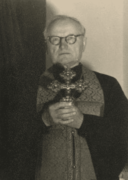
Archpriest Nicholas Raag
By July 1945, the community had managed to obtain a separate facility that had previously been used for bowling, in which “a small but beautiful church” was set up through the efforts of believers. Within a few months, the Ravensburg community had a women’s circle, a Christian youth circle, and courses on dressmaking and sewing, English and French languages, religion, nursing for men and women, and poultry breeding. A small library was started. Preparations were underway to start courses in high-school subjects and curricula and in driving. Archpriest Andrew Nakonechnyi,[54]Mitred Archpriest Andrew Nakonechnyi (1903-May 4, 1983) served in the Polish Orthodox Church from 192? to1944, after which he was in the ROCOR jurisdiction. He served in the German Diocese from 1944 … Continue reading a ROCOR clergyman, took an active role in organizing the parish. On November 1, 1945 Metropolitan Seraphim (Liade) issued a decree accepting the Ravensburg parish into the German Diocese and appointing Fr. Andrew Nakonechnyi assistant priest. The clergy of the Ravensburg parish were charged with serving in all the Orthodox regions of Württemberg where there were no Orthodox priests appointed by the German Diocese.
On December 12, 1945 Fr. Nicholas Raag got actively involved in organizing church life for Orthodox Estonians in Geislingen, which was in the American zone. Fr. Nicholas was able to obtain permission to conduct Orthodox services in the Catholic chapel of an orphanage, and on January 27, 1946 he served the first liturgy there. According to Fr. Nicholas’ data, 4,000 Estonians were living at the time in Geslingen DP camps, 300 of whom were Orthodox. This was where the largest group of displaced Estonians in the American zone was concentrated. Fr. Nicholas instructed the organizing committee of the Geislingen parish to hold negotiations on conducting the legal procedures for setting up an Orthodox community. He simultaneously ministered to the sick in Amberg, Gunzenhausen, and other cities, but the majority of his efforts were directed toward organizing church life in Geislingen. On February 15, 1946 he wrote to Metropolitan Seraphim (Liade): “I have started getting weary lately, but I feel that the most difficult part of uniting Geislingen has been completed, and now everything will be easier. Until I have completely sorted out life there, I will probably not establish a new location, although I am gathering preparatory data and am becoming informed as to what extent this is possible from trip to trip.” Neither did Fr. Nicholas neglect the parish in Ravensburg, although his visits became increasingly rare. In his report to Metropolitan Seraphim (Liade) on June 1, 1946 the second priest at the Ravensburg parish, Fr. Andrew Nakonechnyi, announced that “Fr. Nicholas Raag has from time to time been in Ravensburg during Great Lent, but he has spent more of his time organizing the parish in Geislingen and in other locations in the American zone. He served in Ravensburg during the fourth week of Great Lent. He was supposed to serve Pascha in Geislingen, but after serving there on the first day of Pascha he caught a virulent form of the flu and as a result stayed away from Ravensburg almost until Pentecost.” Soon, Fr. Andrew Nakonechnyi was appointed dean of the French zone of the German Diocese of the ROCOR, and a rotation took place in the Ravensburg parish as well. Fr. Andrew became its rector, while Fr. Nicholas became assistant priest. In the fall of 1947, Fr. Nicholas moved from Germany to Sweden. Fr. Nicholas’ personal file in the archive sheds light only on his move to Sweden (AGE, F.2. Op.1, Korobka 1, D.1, ch.25). As he was in the process of leaving Germany, Fr. Nicholas wrote to Metropolitan Seraphim (Liade) from Geislingen, asking him to release him from the position of assistant priest in the Ravensburg parish. Metropolitan Seraphim’s order released him from this position from November 5, 1947, and also removed his name from the ranks of clergy of the German Diocese.
Archpriest Sergius Samon and others
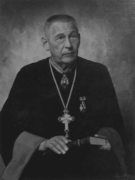
Archpriest Sergius Samon
Metropolitan Alexander (Paulus), head of the EOAP, also left Germany in 1947. The center of Estonian Orthodox life relocated from Ohmstedte to Geislingen. Archpriest Sergius Samon[55]Archpriest Sergius Samon (1902-1993) was born in the Leisi Parish of the Saaremaa District into the family of the well-known clergyman Dionisius (Tonis) Samon (1871-1950). He received his primary … Continue reading became head of the Deanery of the Orthodox Church of Estonia in Germany. Thanks to the questionnaire that was sent out to parishes and clergy of the German Diocese in 1948, we have detailed data about the EAOC Deanery in Germany for 1948 (AGE, F.3, Op,5, Korobka 58, d.58/1).
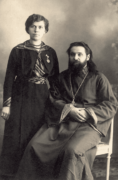
Archpriest Jacob Mutt with his wife Helen
In spite of the fact that this deanery was not part of the German Diocese, Rev. Dean Sergius Samon submitted very complete data regarding the make-up of the clergy in the deanery with which he was entrusted, the number of Estonian parishioners in Germany as a whole, and according to occupation zones in particular. According to Fr. Sergius‘ report, the total population of Orthodox Estonians in Germany was 4,500. The American zone contained 2,800 of them; the British zone had 1,300; and there were 300 in the French zone. Orthodox Estonians resided primarily in IRO camps. The following Estonian clergymen served in the American zone: the dean, Archpriest Sergius Samon, and the priests Nicholas Laisuste and John Reinhold were in Geislingen, Archpriest Carpus Ustav in Bad Worishofen, Priest Bambola Hinesalu in Aschaffenburg, Deacon John Tamm in Memmingen, and Archpriest Nicholas Pavskii in Hanau. The note “m. Seraphim” in this document next to Fr. Nicholas Pavskii’s name indicates that Fr. Nicholas had joined the head of the Berlin-German Diocese. The following priests were in the British zone: Archpriest Jacob Mutt at the Hannover Estonian DP Camp, and the priests Alexander Jurisson, Dioscorus Jurmaia, Nicholas Hindo, and Subdeacon John Jurgenson in the Oldenburg Estonian DP Camp.
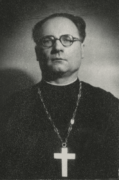
Priest Nicholas Hindo
Fr. Sergius’ report notes the difficult financial situation of the Estonian clergy and the fact that the Estonian Orthodox community in Germany had no financial resources. It should be noted that Fr. Sergei prepared his report shortly before Germany’s financial reform of June 1948, which had a deleterious effect on any person in the displaced persons category. Owing to lack of means, three Estonian priests did not have a riassa and as a consequence were not able to perform their duties. Shortage of priestly vestments was a common problem for Orthodox clergymen in postwar Germany. The archive has countess requests from priests for Metropolitan Seraphim (Liade) to intercede at various levels of authority in order to obtain material for sewing riassas. A similar situation developed in the LOC in the Emigration. The ordination of Peter Kurzemnieks to the priesthood, which took place on April 25, 1948, was delayed due to lack of the means on the part of the LOC Synod and of the ordinand to purchase vestments.[56]A. V. Gavrilin, op. cit., 179.
Fr. Sergius’ report does not mention the clergy in the French zone. There was no single center uniting Orthodox Estonians in the French zone, as Oldenburg did in the British zone or Geislingen in the American Zone. The small number (300) of Orthodox Estonians and their dispersion throughout the French zone did not allow for the creation of a single Estonian parish with a permanent rector. As a result, the Orthodox Estonians in this region received their spiritual care from itinerant priests or from the clergy of the German Diocese.
The years 1948 and 1949 saw the beginning of a massive outflow of DPs from Germany to transatlantic countries. The German Diocese lost most of its clergy, who emigrated together with their flocks to Canada, America, Australia, and other countries. Those of the EAOC clergy who remained in Germany were Fr. Carpus Ustav and Fr. Nicholas Pavskii, who transferred to the ROCOR jurisdiction.
Fr. Nicholas Pavskii, who had served many years at the Cathedral of the Dormition in Yuriev, was rector of the Church of St. Sergius in Hanau from December 12, 1946. Even as a priest of the German Diocese of the ROCOR, he continued to minister to people from the Baltic lands, who formed the backbone of his parish. The Church of St. Sergius was founded on February 24, 1946 by the Lithuanian Archpriest Alexander Chernai and was located in the Estonian DP camp in the attic of a private residence. Initially, the community numbered 100 people, and Sunday services were attended on average by 25 to 30 people. Fr. Nicholas reposed in Offenbach on the Main on June 26, 1950 following a severe illness. Fr. Nicholas’ personal file (AGE, F.2, Op.1, Korobka 9, d.9/7) contains an award of the palitza by the ROCOR Council of Bishops (l.3-6), Fr. Nicholas’ letter to the Chancery of the German Diocese regarding the proposed departure of the Pavskii family to Canada (l.2), and a message from Sergei Pavskii, Fr. Nicholas’ son, to the diocesan administration about his father’s illness (l.1). One document in AGE concerns Sergei Pavskii: a questionnaire for psalmists, which office Sergei performed free of charge at the Hanau parish (AGE, F.2, D. “Regenti i psalomshchiki Germanskoi Eparkhii”). In Estonia, Sergei Pavskii studied in the Orthodox Section of the Theological Faculty of Yuriev University (from 1938 until its closure by the Soviet authorities in October 1940), completing four semesters. From 1937 to 1944, he performed the duties of reader and sang in the choir of the Dormition Cathedral in Yuriev.
Archpriest Carpus Ustav and Others
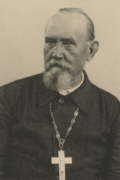
Archpriest Carpus Ustav
Archpriest Carpus Ustav, in spite of his advanced age, took upon himself the duties of ministering to the Orthodox Estonians who remained in Germany. AGE contains Fr. Carpus’ report of May 31, 1949 to Metropolitan Seraphim (Liade) (AGE, F.7, D. “Eparkhial’naia perepiska, 1947 goda”). According to this report, Fr. Carpus was the ROCOR dean in the American and French zones of Germany. He lived in Augsburg at the Hochfeld DP Camp. There were no churches in the DP camps of Fr. Carpus’ deanery. Furthermore, he had no antimension, so services had to be performed in private dwellings without the Divine Liturgy. The report concludes with Fr. Carpus asking Metropolitan Seraphim to send him an antimension. Judging from the note in the report in Metropolitan Seraphim’s handwriting saying “Received one antimension for distribution,” he did fulfill this request. Archpriest Carpus Ustav was a wonderful clergyman, a community figure, and an extraordinary person who is unjustly forgotten today. Upon graduation from the St. Petersburg Theological Academy, he was hired as a teacher at the town school in Toropets in the Pskov Province at the recommendation of the Ober-Procurator of the Holy Synod, K. P. Pobedonostsev. From 1896 to 1905, he served as inspector of public schools in Toropets. When already a priest in the Pechory Region, he was the founder of an Estonian language primary school in 1913. He started the first Seto language school in the village of Sergo, and services started to be held in the Seto language.[57]Archimandrite Tikhon (Sekretarev), Vrata nebesnye: istoriia Sviato-Uspenskogo Pskovo-Pecherskogo Monastyria (Pechora: Sviato-Uspenskii Pskovo-Pecherskii monastyr‘, 2008), 277. Fr. Carpus served for several decades in the EAOC. When in emigration in Germany, he devoted his remaining strength to serving his compatriots, the Orthodox Estonians. He reposed on August 18, 1953 in Augsburg. Fr. Carpus was followed by the last EAOC priest in Estonia, Fr. Theodore Kolobov of the EAOC. He was ordained to the priesthood in Bad Nauheim by Archbishop Athenagoras, Patriarchal Exarch in Western and Central Europe and by Archbishop Philotheos (Narko), Administrator of the Gross-Hessen Vicariate of the Western German Diocese of the ROCOR.[/ref] AGE holds several documents reflecting Fr. Theodore‘s activity in Oldenburg, the former center of the EAOP in Germany (AGE, F.7, D, “Eparkhial‘naia perepiska, 1952 g.“). This was correspondence regarding ministering to the Oldenburg Estonian community. It was initiated by representatives of the Landplatz Estonian community organization, and warden Verbanov of the Church of the Holy Protection in Oldenburg wrote to Archbishop Alexander (Lovchii). The community had a few Estonians who did not speak Russian and wished to have their confessions heard in their native tongue. It follows from Verbanov‘s letter that the World Council of Churches had appointed the priest Theodore Kolobov to serve in Germany‘s Estonian Orthodox parishes after he was ordained to the priesthood. The community, which had presumably been founded in 1946 or 1947, obtained its own church in 1950. This was in a barrack in an Estonian DP camp. Services were celebrated in the main by priests from the ROCOR. After its rector, Fr. John Karas,[58]Archpriest John Karas (1909-1997) served in the German Diocese of the ROCOR from 1945 to 1952 . The parish was taken over by priest Nicodemus Kofanov (1887-1965), who served in the German Diocese of the ROCOR from 1950 to 1965. [/ref] left for America, permission was received from Archbishop Alexander Lovchii for Fr. Theodore Kolobov to serve at the Church of the Holy Protection for Estonians living in Oldenburg. The correspondence especially emphasized the issue of coordinating the times when services would be conducted by Fr. Nicodemus Kofanov and Fr. Theodore Kolobov. We do not know how frequently and for how long Fr. Theodore held services in Oldenburg. The brief history of the Church of the Holy Protection in Oldenburg includes Fr. Theodore in the list of priests in charge of this church in the first half of the fifties.[59]Istoriia prikhoda Pokrova Presviatoi Bogoroditsy RPTsZ g. Ol’denburga, www.zerkov.de.index.html. Fr. Theodore emigrated from Germany in the mid-fifties.
Concluding this overview of AGE documentation on the Estonian theme, separate note should be made of those clergymen of the German Diocese who were connected with Estonia during the war and in the prewar years, and Estonian émigrés who were ordained within the ROCOR but did not take part in the activity of the EAOP in Germany. Circumstances developed in such a way that almost all of them presented themselves as close co-workers and concelebrants at God’s altar in Germany. These include Archpriest Alexander Kiselev and the priests Dimitri Gisetti and Anatole Dreving.
Protopresbyter Alexander Kiselev
Fr. Alexander Kiselev (1909-2001), a well-known clergyman of the Russian diaspora, came to Germany from Estonia in 1941, a few months before the war started between Germany and the Soviet Union. He graduated from the Riga Theological Seminary and was ordained to the priesthood by Metropolitan Alexander (Paulus) in 1933. He served as rector of the Church of the Dormition in Narva from 1933 to 1938 and of the Koppel St. Nicholas Church in Tallin from 1938 to 1941, where Fr. Michael Ridiger[60]Archpriest Michael Ridiger (1902-1962) served in the EAOC and the EOC of the Moscow Patriarchate. was deacon, whose son Alexei, the future Patriarch of Moscow and All Russia Alexis II,[61] Alexis II (Ridiger, 1929-2008), His Holiness Patriarch Alexis II of Moscow and All Russia from 1990 to 2008. served in the altar. He was an active participant in the RCSM (Russian Student Christian Movement) and was its representative in Estonia from 1935. In Germany, he joined the Western European Exarchate of Russian Parishes of the Patriarchate of Constantinople under Metropolitan Evlogii (Georgievskii). According to an agreement of November 3, 1939 between Metropolitan Seraphim (Liade) and Metropolitan Evlogii‘s assistant Bishop Sergius (Korolev),[62]Archbishop Sergius (Korolev, 1881-1952) was consecrated on April 17, 1921 as Bishop of Belsk at the Monastery of the Holy Spirit in Vilnius. From 1922 to 1946, he was Bishop of Prague, assistant to … Continue reading the “Evlogian” parishes, retaining their independence, joined the Berlin-Germany Diocese of the ROCOR.
The AGE documents shed light on Fr. Alexander’s years of service in Germany only in a fragmentary manner. The wartime diocesan correspondence contains a few of his letters, one of which is interesting from the point of view of characterizing his ministry in Estonia. He writes the following in a letter to Abbot Alexander (Lovchii) on November 9, 1942: “…there is nothing better than one’s own independent small parish. The Lord favored me with such parishes during my first eight years of serving in Estonia. But now that I’m in Germany, things have gone somewhat differently — there’s more fuss but fewer results (AGE, F.7, D. “Eparkhial’naia perepiska, 1942 goda”). Several letters are devoted to Fr. Alexander’s activity as Associate Head of the Missionary Committee of the German Diocese and chaplain of the Russian Army of Liberation.
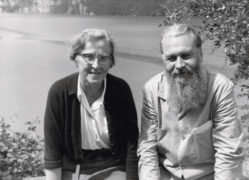
Archpriest Alexander Kiselyov with his wife Callista Ivanovna. Switzerland. 1964 Photo from the personal archive of E.A.Zhdanova (Frankfurt am Main)
The number of documents dealing with Fr. Alexander increases significantly in the postwar period as a consequence of his active work in organizing the Home of the Good Samaritan in Munich. First of all, there is Fr. Alexander’s personal dossier, almost all of the documents in which are devoted to his activity in the home he founded (AGE, F.2, Op.1, Korobka 1, d.1, ch.14). Secondly, there is the “Mauerkircherstrasse 5” file,[63]This file takes its name from the address of the Home of the Good Samaritan in Munich, which later housed the Diocesan Administration of the German Diocese. which allows us to trace the history of the home, its grammar school, and its Church of St. Seraphim from its founding in 1945 until 1975. The Home of the Good Samaritan was a unique institution which housed a Russian grammar school with credentials equal to those of Bavarian public high schools, a nursery school, a publishing house, an outpatient medical clinic, and a school of nursing. The Church of St. Seraphim of Sarov, created through the labors of Fr. Alexander, was the center of the life of the home. The documents in this file also reflect Fr. Alexander’s work towards the restoration of the RSCM in Germany, and the Church of St. Seraphim at the home was reorganized into an RCSM parish. Among Fr. Alexander’s active co-workers in restoring the RSCM in Germany were Baltic movement participants Fr. George Benigsen (Latvia),[64]Mitred Archpriest George Benigsen (1915-1993) was ordained to the diaconate in 1937 by Metropolitan Augustin (Petersons), and in 1941 Metropolitan Sergius (Voskresenskii), Exarch of the Baltic Lands, … Continue reading Fr. Dimitri Gisetti with his wife Margarita Gisetti (Bang), (Estonia), and Fr. Alexander’s matushka Kallista Ivanovna (Kel’ner). Fr. George‘s and Fr. Alexander‘s destinies share many similarities. Both of their parents, taking advantage of the right of optation, left the Soviet Union with their families. Both, while still laymen in the thirties, became actively involved in RSCM activity, where they met their future spouses. Their paths crossed again in the emigration. In 1944, they both became actively involved in the activity of the Committee of the Liberation of the People of Russia and ministering to the Vlasov movement. After the war, the RCSM brought them together once more. After moving to Munich, Fr. George started serving at the Church of St. Seraphim at the Home of the Good Samaritan. While a priest in the community of Archpriest Adrian Rimarenko[65]Mitred Archpriest Adrian Rymarenko (1893-1978) was a clergyman in the German Diocese from 1943 to 1949. He was tonsured in 1968 with the name Andrew and consecrated as Bishop of Rockland and Vicar of … Continue reading in Wendlingen in 1948, he was appointed secretary of the RCSM in Germany. In Munich, he was editor of the RCSM Vestnik. After Fr. Alexander’s departure to America in 1949, Fr. George was appointed rector of the Church of St. Seraphim and also emigrated to America in 1950.
Fr. Alexander Kiselev is one of the few priests whose AGE files have been significantly augmented over the past few years. A few dozen documents connected to the history of his service in Germany were received from personal archives between 2009 and 2014. These are the memoirs of Archpriest Nicholas Artemov[66]Archpriest Nicholas Artemov (b. 1950), is secretary of the German Diocese of the ROCOR and sacristan of the Cathedral of the Holy New Martyrs and Confessors of Russia and St. Nicholas in Munich. His … Continue reading (Munich, 2007), covering the period from 1945 to 2001, and the memoirs of Margarita Maas-Kutshe (Munich, 2008). Among the documents that Fr. Nicholas handed over to the archive is a recording of a panikhida following the unveiling of a memorial stone presented to ROA fighters in Plattling with speeches by Fr. Alexander and K. G. Kromiadi, and of a discussion between Moscow historian A. K. Nikitin and Fr. Alexander at Moscow‘s Donskoi Monastery of December 7, 1996 with the participation of Fr. Nicholas Artemov and Fr. Alexander‘s daughter Militsa Kholodnaya. This discussion took place in the course of the historian‘s work on the monograph Natsistskii rezhim i russkaia Pravloslavnaia obshchina v Germanii (1933-1945) [The Nazi Regime and the Russian Orthodox Church in Germany, 1933-1945] and is devoted in the main to the wartime period.
One of his closest collaborators in Germany was the priest Dimitri Gisetti. Fr. Dimitri was born in 1918 in Petrograd into the family of an officer of the czarist and later the White Army. Following General Yudenich, the Gisetti famiy fled to Estonia. Dimitri practically grew up in Estonia’s RCSM camps, where he became acquainted with Fr. Alexander Kiselev, under whose guidance he undertook a pilgrimage to Valaamo. He was mobilized in August 1941 and sent to the front, where he was wounded and taken prisoner by the Germans. After the war, he made his way to Munich, where he became an active participant in the work of the Home of the Good Samaritan. Fr. Dimitri‘s insubstantial file (six documents in all) (AGE, F.2, Op.1, Korobka 3, d.3/7) reflects all of the different phases of his two-year pastorate in Germany. With Fr. George Benigsen as rector of the Church of St. Seraphim, Fr. Dimitri was appointed as its assistant priest. In January 1950, he received a canonical release from Metropolitan Seraphim (Liade) and went to America, where he worked for a few years with Fr. Alexander Kiselev to set up the Church of St. Seraphim of Sarov in New York in the jurisdiction of the Orthodox Church in America (OCA). Fr. Anatole Dreving continued Fr. Alexander‘s work in Munich as pastor of the Church of St. Seraphim in 1950. His personal file gives an account of his life before coming to Germany (AGE, F.2, Op.1, Korobka 3, d.3/19). He was born in Moscow in 1910 and lived in Estonia. He graduated from Tartu University in chemistry and was ordained to the priesthood in 1950 in Munich, with an appointment to the post left vacant by Fr. George Benigsen‘s departure to America. At the same time, he was appointed spiritual father to the Christian Union of Young People (CUYP), a movement which emerged in Germany in parallel with the RCSM. The previous spiritual fathers of the CUYP had been Fathers Alexander Kiselev and George Benigsen successively. When it was still under Fr. George‘s rectorship, the Church of St. Seraphim was declared an independent parish. Owing to the departure of Russians from Germany, the grammar school at the Home of the Merciful Samaritan was becoming redundant. The Russian children who remained in Munich went to German schools. In 1953, classes in religious studies were organized at the parish, which was recognized by the Bavarian Education Ministry as a mandatory subject. In 1964, the parish had to vacate the premises, and the church temporarily crowded into Fr. Anatole‘s apartment. The Protestant Church provided accommodation for the lessons in religious studies. Here is what Fr. Anatole wrote in the sixties: “…the parish, which is no more than the house church of an educational institution, conducted and conducts multi-faceted cultural education work with young people.” With Fr. Anatole‘s repose in 1969, the period of Munich‘s Church of St. Seraphim being served by priests connected to the Baltic Lands came to a close. The parish still continued to exist for a few more years, notwithstanding, celebrating its fortieth anniversary in 1975. The documents in Fr. Anatole Dreving‘s personal file in the AGE are supplemented by data on his ministry in the documents in the Mauerkirhenstasfe 5 file, which is a fascinating resource for research into the activity of the Home of the Good Samaritan and the history of the Church of St. Seraphim in Munich. Fr. Anatole is also known as a church composer of the Russian diaspora.
Thus, in conclusion it may be said that, in contrast to the LOC in the Emigration, the EAOC did not have extensive contacts with the ROCOR. Collaboration with the German Diocese of the ROCOR was in the main initiated by ordinary Estonian priests. Thanks to these contacts, it is possible in part to trace the destinies of Estonian Orthodox communities in Germany.
Conclusion
The German Diocese of the ROCOR has preserved unique materials on the history of displaced individuals in Germany in the extremely complicated circumstances of the wartime period, including on those from the Baltic region. The AGE documents only partially reflect the life of the Lithuanian DP camps and Lithuanian Orthodox communities in mixed camps. The history of the Estonian DP camps with their Orthodox communities is brought to light in more detail. The history of the Latvian Orthodox community in Germany has a relatively rich and extensive source base. For those researching the histories of the EAOC and the LOC in the Emigration, the AGE documents will undoubtedly be one of the most significant sources for studying the German period of their existence. In connection with the fact that a large number of Baltic clergy were forced to leave Lithuania, Latvia, and Estonia as a result of the events of the Second World War, many of them ended up being forgotten in their native countries, so that the personal files of these clergymen are a matter of especial interest. The personal files of priests reflect the wartime era and the suffering of displaced persons who had lost their homelands, and they recount the selfless ministry of Orthodox pastors in postwar Germany.
References
| ↵1 | Augustins (Petersons, 1873-1955) was Metropolitan of Riga and All Latvia from 1936. Between 1936 and 1941 and between 1947 and 1955 he was under the Ecumenical Patriarchate. In 1941 he transferred to the Moscow Patriarchate and was evacuated to Germany in 1944. He reposed in Gauting, a suburb of Munich. |
|---|---|
| ↵2 | Metropolitan Alexander (Paulus, 1872-1953) was head of autonomous Estonian Orthodox Church under the Russian Orthodox Church between 1920 and 1923, after which he was under the Ecumenical Patriarchate. He was temporarily under the Moscow Patriarchate after repentance in 1941. He was evacuated to Germany in 1944 and emigrated to Sweden in 1947. |
| ↵3 | Archbishop John (Garklavs, 1898-1982) was consecrated to the episcopate on March 13, 1943 as Bishop of the Riga Baltic Exarchate of the Moscow Patriarchate. In 1944 he left Latvia with a group of clergy for Czechoslovakia, and in August 1945 he went to Germany. In 1949 he emigrated to America, where he joined the North American Metropolia. From 1949 to 1957 he was Bishop of Detroit and Cleveland, and Archbishop of Chicago and Minneapolis from 1957 to 1978, after which he went into retirement. He was the guardian of the Tikhvin Icon of the Mother of God. |
| ↵4 | Archbishop Alexander (Lovchii, 1891-1973), was consecrated as Bishop of Bad Kissingen, Vicar of the ROCOR Diocese of Germany on July 29, 1945. He became Archbishop of Berlin and Germany on April 11, 1952 and went into retirement on March 15, 1971. Metropolitan Alexander (Paulus) lived in Germany for only three years and emigrated to Sweden in 1947. The number of Estonian and Latvian Orthodox communities decreased as priests of the EAOC and the LOC emigrated in 1948 and 1949. The Baltic Orthodox presence in wartime and postwar Germany could not fail to be reflected in the archives of the German Diocese of the ROCOR. This article gives an account of the archival documents relating to Baltic Orthodoxy in Germany. The documents regarding each Baltic country have their own special character, conditioned first of all by the degree of interrelationship between the Baltic churches and the ROCOR and the history of the Orthodox communities in the Baltic lands prior to their evacuation to Germany. |
| ↵5 | These decrees were passed by Tikhon (Belavin, 1865-1925), Patriarch of Moscow and All Russia from November 21, 1917 (o. S.) the first patriarch after the restoration of the patriarchate in Russia. He was Archbishop of Vilnius and Lithuania from 1914 to 1917. In 1981, the ROCOR glorified him among the Host of the New Martyrs and Confessors of the Russian Church. He was glorified by the Moscow Patriarchate in 1989. |
| ↵6 | Pravoslavnaia Entsiklopedia [Orthodox Encyclopedia] (TsNTs RPTs [Center for Church Research of the Russian Orthodox Church]: Moscow 2000) v. 1, 499-501. |
| ↵7 | Meletios IV (Metaxakis, 1871-1935), Patriarch of Constantinople from February 2, 1921 to September 20, 1923. |
| ↵8 | I. V. Petrov, Vopros o kanonicheskoi prinadlezhnosti pravoslavnykh prikhodov Baltii v 1940-1945 gg. [The Issue of the Canonical Jurisdiction of Baltic parishes from 1940 to 1945], published on March 28, 2013. |
| ↵9 | Hieromartyr John (Pommer, 1876-1934), Archbishop of Riga and All Latvia, was Primate of the LOC from 1921 to1934. He was glorified by the ROCOR in 1981, and by the LOC and the ROC in 2001. See Latviia kak avtonomiia, no bez loial’nosti SSSR [Latvia as an Autonomous Region, but without Loyalty to the USSR}. |
| ↵10 | Metropolitan Eleftherios (Bogoiavlenskii, 1868-1940) was consecrated as Bishop of Kaunas, Dean of the Diocese of Lithuania on August 21, 1911. He was head of the Diocese of Lithuania from 1917 on, and was made Archbishop of Vilnius and Lithuania in 1921 and Metropolitan in 1928. |
| ↵11 | Benjamin (Psomas Kiriakou) (1871-1946) was Patriarch of Constantinople from February 18, 1936 to February 17, 1946. |
| ↵12 | Karlis Ulmanis (1877-1942) was a Latvian political and governmental figure. He occupied the post of Prime Minister of Latvia several times from 1918 on. Between 1934 and 1940 he was Latvia’s dictator (becoming president in 1936). |
| ↵13 | A. V. Gavrilov, “Dokumenty po delu mitropolita Rizhskogo i vseia Latvii Avgustina (Petersonsa) ‘Latviiskoi papki’ arkhiva Arkhireiskogo Sinoda Russkoi Pravoslavnoi Tserkvi Zagranitsei.” Sbornik Pravoslavie v Latvii, no. 5 [Documents in the Matter of Metroplitan Augustins (Petersons) of Riga and All Latvia in the ”Latvian File” in the Archive of the Bishops’ Synod of the Russian Orthodox Church Outside Russia. Collection ”Orthodoxy in Latvia” no. 5] (Riga: Philokalia), 101. |
| ↵14 | Antanas Smetona (1974-1944) was a political and governmental figure in Lithuania. He was the first president of the Lithuanian Republic from 1919 and 1920. From 1926 to 1940, he was dictator of the Lithuanian Republic. |
| ↵15 | Priest Vitalii Serpinas, ”Pravoslavnaia Tserkov’ v Litve v mezhvoennyi period, 1918-1939 gg.“ [The Orthodox Church in Lithuania in the Interwar Period, 1918-1039] Pravoslavie v Baltike no. 2 (11) (2014): 60. |
| ↵16 | Theodosius (Feodoseev, 1864-1942) was Archbishop of Vilnius and Lida under the Polish Orthodox Church from 1923 to 1939. In 1939 he joined the Moscow Patriarchate and went into retirement until his repose. |
| ↵17 | Sergius (Stragorodskii, 1867-1944). Patriarch of Moscow and All Russia from September 12, 1943 to May 15, 1944. He was Acting Locum Tenens of the Patriarchal Throne from 1925 to 1936 and Locum Tenens from 1936 to 1943. |
| ↵18 | Sergius (Voskresenskii, 1897-1944) was Bishop of Dmitrov from February 1936 (Archbishop from October 8, 1937) and administrator of the Moscow Diocese. From February 24, 1941 he was Metropolitan of Vilnius and Lithuania and Exarch of Latvia and Estonia. He was murdered on April 29, 1944 on the way from Vilnius to Kaunas. |
| ↵19 | Archbishop Daniel (Yuzviuk, 1880-1965) took the position of temporary administrator of the Diocese of Vilnius and Lithuania with the rights of acting Patriarchal Exarch of the Baltic Lands, according to the provisions of a testament of the Exarch of the Baltic Lands from October 1943. |
| ↵20 | Pravoslavnaia entsiklopedia, loc. cit. |
| ↵21 | Archbishop Paul (Dmitrovskii, 1872-1946) was consecrated as Bishop of Narva (EAOC) on October 3, 1937. After canonical relations with the Moscow Patriarchate were restored in 1941, Bishop Paul resisted the efforts of Metropolitan (Paulus) to once again break relations with the Moscow Patriarchate. On December 21, 1942 Exarch Sergius (Voskresenskii) elevated him to the rank of archbishop, and on April 16, 1945 he was appointed Archbishop of Tallin and Estonia. |
| ↵22 | Archpriest Nicholas Pavskii, 1891-June 26, 1950) was born in the St. Petersburg province to a priestly family and graduated from the St. Petersburg Seminary in 1914. He was ordained to the diaconate by bishop Gennadios (Tuberozov) of Narva and to the priesthood in 1915 by Bishop Benjamin (Kazanskii) of Gdovsk. He served at the Cathedral of the Dormition in Yuriev and became archpriest in 1937. In 1944 he was evacuated from Estonia to Germany and was appointed rector of St. Sergius Church in Hanau on December 14, 1946. |
| ↵23 | The statistical data are from “Baltijas valstu beglu nometnes Vacija 1944-1951“ |
| ↵24 | Abbreviation for ”displaced persons,” designating persons forced to abandon their permanent residences. The term gained widespread usage as a result of the events of the Second World War. |
| ↵25 | Hieroconfessor Agafangel (Preobrazhenskii, 1854-1928), Bishop of Riga and Mitava (Archbishop from 1904) from October 4, 1897 to August 13, 1910. Archbishop of Lithuania and Bryansk from August 13, 1910 to December 22, 1913, and after that Archbishop of Yaroslav and Rostov (Metropolitan from 1917). Took part in the Local Council of 1917-1918. He was a member of the Supreme Church Council and a candidate for Locum Tenens of the Patriarchal Throne according to the testaments of Patriarch Tikhon (Belavin). Glorified as a hieroconfessor with the host of New Martyrs and Confessors of Russia in 2000. |
| ↵26 | Metropolitan Seraphim (Liade, 1893-1950) was appointed as ROCOR Bishop (Metropolitan from 1939) of Berlin and Germany in 1938. From 1942 he headed the Central European Metropolitan District of the ROCOR in the rank of metropolitan. |
| ↵27 | Metropolitan Evlogii (Georgievskii, 1868-1946) was appointed on March 26, 1921 by Patriarch Tikhon (Belavin) as temporary administrator of the Russian Orthodox parishes in Western Europe. On June 10, 1930 he was banned from serving by Metropolitan Sergius (Stragorodskii) and relieved of his position. In 1931, he transferred to the Patriarchate of Constantinople and was appointed Exarch of the Patriarch of Constantinople in Western Europe. In 1945, he rejoined the Moscow Patriarchate. |
| ↵28 | D. B. Zhdan, ”Diadiushka Pavel. Pavel Olimpievich Savitskii – russkii intelligent bez Rossii” [Uncle Pavel. Pavel Olimpievich Savitskii – A Russian Intellectual Without Russia], http//www.ruslo.cz/articles/829. |
| ↵29 | Hieromartyr Andronik (Nikolskii, 1870-1918) was Archbishop of Omsk and Pavlodar from March 8, 1913 to July 30, 1914 and was martyred on June 20, 1918. The Moscow Patriarchate glorified him in 2000 for general veneration by the Church. |
| ↵30 | ++ The Internal Orthodox Mission in Lithuania was created in early 1944 by Metropolitan Sergius (Voskresenskii) with the purpose of serving the needs of refugees in Lithuania. Its activity continued until July 1944. Members of the mission evacuated to Germany include Fr. Gerasim Shorets, Fr. Alexander Chernai, Fr. John Kharchenko, and Fr. Sergius Kargai. |
| ↵31 | Archpriest Gerasim Shorets, Vseobshchaia tserkovnaia istoriia {General Church History], (Munich: Missionerskii komitet Germanskoj eparkhii, 1949), 76. |
| ↵32 | Metropolitan Dionisius (Valedinskii, 1876-1960) of Warsaw and Volyn, was primate of the Polish Orthodox Church in the Patriarchate of Constantinople jurisdiction from 1923 to 1948. In 1948, he sent a letter of repentance to Patriarch Alexis I of Moscow and All Russia, and on June 22, 1948 the act granting autocephaly to the Polish Orthodox Church was signed in Moscow. That same year, Metropolitan Dionisius was relieved of his position by the Polish authorities. |
| ↵33 | A. A. Kornilov, ”Perepravimsia na tu storonu…“ Deiatel‘nost‘ pravoslavnogo dukhovenstva v lagere peremeshchionnykh lits Shliaisgaim (1945-1951 gg.) [”We Will Cross Over to the Other Side… The Activity of the Orthodox Clergy in the Schleissheim Displaced Persons Camp (1945-1951)], (N. Novgorod, Munich, 2011), 88-90, and material from the web page of the Grodno Diocese of the Belarus Exarchate of the ROC. |
| ↵34 | The question of which bishop ordained Fr. John remains open. From 1919 to 1928 the Tver’ Diocese was occupied by Metropolitan Seraphim (Alexandrov), who was repeatedly arrested by the GPU-OGPU. Between 1922 and 1924 the vicar for the Tver’ Diocese was the Bishop Martyr Peter (Zverev, 1878-1928) of Staritsa. Bishop Peter already had the rank of archbishop at the indicated time of Fr. John’s ordination to the diaconate, but was administrator of the Voronezh and Zadonsk Dioceses. In addition, Archbishop Peter was once again arrested on November 29, 1926 and was in OGPU prisons until 1927, when he was sentenced to ten years in a concentration camp and sent to Solovki, where he reposed in 1929. |
| ↵35 | K. P. Oboznii, Istoriia Pskovskoi Pravoslavnoi Missii 1941-1944 gg. [History of the Pskov Orthodox Mission, 1941-1944], (Moscow: Izd-vo Krutitskogo podvor’ia i Obshchestva liubitelei tserkovnoi istorii, 2008). |
| ↵36 | Archimandrite Alexis Chernai, Zhiznennyi put’ russkogo sviashchennika [The Life’s Journey of a Russian Priest], (San Francisco: Globus), 198?, http://ricolor.org/historypv/45/. |
| ↵37 | Archbishop Nathaniel (Lvov, 1906-1986) was assistant abbot of the Monastery of St. Job of Pochaev in Ladomirov during the Second World War. In 1945, he was appointed rector of the Cathedral of the Resurrection in Berlin. After the war, he served in Hamburg as administrator for the North German part of the diocese. He played an active role in rescuing displaced persons, preventing the repatriation of around 600 people to the USSR in Fishbeck outside Hamburg. On March 10, 1946 he was consecrated Bishop of Brussels and Western Europe. From 195? he was Bishop of Preston and the Hague. From 1942, he was administrator of ROCOR parishes in Northern Africa. He lived in Munich at the Monastery of St. Job of Pochaev from 1954, and was its abbot from 1966 to 1980. He temporarily administered the Austrian Diocese from 1971 and became Bishop of Vienna and Austria in 1976 (Archbishop in 1981). |
| ↵38 | The priest George Freiman (Freimanis) (September 28, 1895-?) served in the LOC in the emigration. He was born in Liepaja to a German Lutheran family. He graduated from the Commercial Institute in Liepaja and the Riga Theological Seminary. In 1936, he turned down an offer from Metropolitan Augustins to ordain him to the priesthood with an assignment to Saldus. Metropolitan Augustins regarded him as a worthy candidate for the priesthood. ”He completed the course at the Riga Theological Seminary, although the supervisors and teachers were of poor quality, but he turned out to be one of the best candidates for the priesthood.“ (From a letter of Metropolitan Augustins to Metropolitan Seraphim (Liade) of December 8, 1945. (AGE, F.2, D. “Svishchenniki A-Shch, 1945-1948, ch.31). He evacuated to Germany in 1944, where he found Metropolitan Augustins. At the request of the head of the LOC, Bishop Stephen (Sebo) ordained George on February 15 to the diaconate, and on February 2, 1946 to the priesthood. He moved to London at the end of the forties. |
| ↵39 | Archbishop Stephen (Sevbo, 1872-1965) was consecrated on May 17, 1942 as Bishop of Smolensk and Bryansk of the Belarusian Metropolitanate of the Moscow Patriarchate. He evacuated to Germany in 1944 and on February 2, 1945 entered the ROCOR jurisdiction. |
| ↵40 | The documents in the archives of the ROCOR Synod of Bishops on this subject have been published in full in A. V. Gavrilin, ”Dokumenty po delu mitropolita Rizhskogo i vseia Latvii Avgustina (Petersons) ‘Latviiskoi Papki’ Arkhiva Arkhiereiskogo Sinoda Russkoi Pravoslavnoi Tserkvi Zagranitsei“ [Documents in the Matter of Metropolitan Augustins (Petersons) of Riga and All Latvia in the ”Latvian File” of the Archive of the Synod of Bishops of the Russian Orthodox Church Abroad] in Sbornik ”Pravoslavie v Latvii“ no. 5, op. cit. |
| ↵41 | John Molotok (August 28, 1915-?) was born in the Piedruja district of the province of Vitebsk. In 1933, he graduated from the Belarusian State Grammar School in Dvinsk and the Theological Department of the University of Latvia. He was ordained to the diaconate on October 9 and to the priesthood on October 16, 1938 by Metropolitan Augustins of Latvia, and served parishes in Liepna, Aloja, and Riga. After evacuating from Latvia in 1944 he received permission from Metropolitan Seraphim (Liade) to serve in the churches of the German Diocese of the ROCOR. From 1944 to 1945, he served in Danzig. From 1945 on, he was in Esslingen and Stuttgart. He received a canonical release in 1949 from Metropolitan Seraphim (Liade) in connection with a proposed departure to North Carolina, but his emigration did not take place. From January 1, 1950 he was on the staff of the church in the Funk Barracks (Stuttgart). |
| ↵42 | Archpriest John Liepins (February 13, 1900-1986) graduated from the Riga Theological Seminary in 1933. On July 1, 1934 he was ordained to the priesthood by Archbishop John (Pommer) of Riga and All Latvia. He served in the Anarkas (?) and Burnieks parishes. He evacuated to Germany in 1944 and practically did not serve at all between 1944 and 1946 owing to ill health. In 1946, Metropolitan Augustins appointed him to the parish in Esslingen. He reposed in the USA. |
| ↵43 | Gavrilin, op. cit., 101. |
| ↵44 | Metropolitan Germanos (Strenopoulos, 1872-1951) was the head of the Thyatira Metropolitanate with its center in London from 1922 and the Patriarchal Exarch in Central and Western Europe. On February 4, 1936 he was appointed representative of the Patriarch of Constantinople to take part in the Council of the LOC at which Archpriest Augustins Petersons was elected to head that Church. On March 29, 1936 he took part in the consecration of Fr. Augustins as Metropolitan of Riga and All Latvia. |
| ↵45 | Metropolitan Theophilus (1874-1950) was Metropolitan of All America and Canada from 1934. |
| ↵46 | John Briedis (December 4, 1914-September 15, 1948) was a priest in the LOC (LOC in the Emigration). From 1935 to1936 he served at the Monastery of the Holy Spirit in Ekabspil (?). From 1942 to 1943 he served parishes in Rujiena, Skulberg (?), and Aloja. From July 16, 1943 he was assigned to the Karzdaba and Lideris parishes. For now, it is not clear how he came to end up in Buchenwald, but according to his own statement he was freed from this camp after Germany capitulated. (AGE, F.2, D. ”Sviashchenniki A-SHCH, 1945-1949), ch.4, l.1). From 1946, he was rector of the church in the Esslingen Latvian Camp. He died of diphtheria. |
| ↵47 | Vladimir Skilins (April 25, 1902-?) was a clergyman in the LOC. He was born to a Latvian family that had converted to Orthodoxy in 1845. He graduated from the Riga Theological Seminary and the Latvian University in theology and law. He worked in Latvia’s Ministry of Public Works and was ordained to the priesthood on August 18, 1940 by Metropolitan Augustins (Petersons), and then served at the Kalsnava parish. On March 17, 1943 he was assigned as rector of the Marciana and the Vesiens-Tolga (?) parishes. He came to Germany in 1944, where he received permission from Metropolitan Seraphim (Liade) to serve in churches of the German Diocese with the consent of local rectors. He was dean of the Latvian camps in the British zone. |
| ↵48 | Anthony Gramotyns was a priest of the LOC (LOC in the Emigration). He was born to an Orthodox Latvian family, and was an officer of the Russian army, a participant in the First World War and in the fight for Latvian independence, and was demobilized due to illness as a lieutenant colonel. After Latvia was occupied by the Germans, he was called to serve in the Latvian police. In October 1944 he was evacuated to Germany and relieved of his position. In 1946, he organized the Latvian Orthodox parish in Lübeck. From April 1947, he helped Fr. Vladimir Skilins to organize worship in the Latvian DP camps. At Metropolitans Augustins‘ request he was ordained to the diaconate by Bishop Afanasii (Martos) on July 21 and to the priesthood on July 27, 1947. He served in Great Britain in the fifties. |
| ↵49 | Archbishop Afanasii (Martos, 1904-1983) was consecrated in 1942 as Bishop of Vitebsk. In June 1944, he left the USSR along with the Belarusian episcopate. He joined the ROCOR in 1946 and was appointed administrator and ruling hierarch of the North German Diocese with his see in Hamburg. He left Germany in 1950. |
| ↵50 | Vladimir Tolstoukhov (1914-?) was a former clergyman of the LOC, the Latvian diocese of the Moscow Patriarchate, the ROCOR, and the Western European Exarchate of Russian Parishes under the Patriarchate of Constantinople. He was suspended on August 14, 1950 and defrocked on October 21, 1950 by Metropolitan Vladimir (Tikhonitskii) |
| ↵51 | Metropolitan Vladimir (Tikhonitskii, 1873-1959) ruled the Western European Exarchate of Russian Parishes under the Patriarchate of Constantinople from March 6, 1947 (de facto from August of 1946) until his repose. |
| ↵52 | Metropolitan Anastasius (Gribanovskii, 1873-1965) was the First-Hierarch of the ROCOR from 1936 to 1964 and head of the Bishops’ Council and Synod. He retired in 1964. |
| ↵53 | On December 1, 2014 the remains of Bishop Constantine (Essenskii) were moved from a cemetery in Texas to the brotherhood cemetery of the Holy Trinity Monastery in Jordanville. When the casket was opened his body was discovered to be incorrupt. His panikhida was conducted by the First-Hierarch of the ROCOR Metropolitan Hilarion (Kapral), who had conducted Bishop Constantine‘s funeral eighteen years before as Bishop of Manhattan. |
| ↵54 | Mitred Archpriest Andrew Nakonechnyi (1903-May 4, 1983) served in the Polish Orthodox Church from 192? to1944, after which he was in the ROCOR jurisdiction. He served in the German Diocese from 1944 to 1951, ministering to the Orthodox in the DP camps in Germany. |
| ↵55 | Archpriest Sergius Samon (1902-1993) was born in the Leisi Parish of the Saaremaa District into the family of the well-known clergyman Dionisius (Tonis) Samon (1871-1950). He received his primary education in Kuressare and graduated from the Nicholas Grammar School in Riga and the Riga Theological Seminary. He was ordained to the diaconate on September 9 and to the priesthood on September 14, 1924. In 1944, he was evacuated to Germany. He served as dean of the EAOC in Germany and rector of the church in Geislingen. He emigrated to America in 1949. |
| ↵56 | A. V. Gavrilin, op. cit., 179. |
| ↵57 | Archimandrite Tikhon (Sekretarev), Vrata nebesnye: istoriia Sviato-Uspenskogo Pskovo-Pecherskogo Monastyria (Pechora: Sviato-Uspenskii Pskovo-Pecherskii monastyr‘, 2008), 277. |
| ↵58 | Archpriest John Karas (1909-1997) served in the German Diocese of the ROCOR from 1945 to 1952 |
| ↵59 | Istoriia prikhoda Pokrova Presviatoi Bogoroditsy RPTsZ g. Ol’denburga, www.zerkov.de.index.html. |
| ↵60 | Archpriest Michael Ridiger (1902-1962) served in the EAOC and the EOC of the Moscow Patriarchate. |
| ↵61 | Alexis II (Ridiger, 1929-2008), His Holiness Patriarch Alexis II of Moscow and All Russia from 1990 to 2008. |
| ↵62 | Archbishop Sergius (Korolev, 1881-1952) was consecrated on April 17, 1921 as Bishop of Belsk at the Monastery of the Holy Spirit in Vilnius. From 1922 to 1946, he was Bishop of Prague, assistant to Metropolitan Evlogii (Georgievskii). On October 15, 1945 he joined the Moscow Patriarchate and from 1946 to 1948 was Archbishop of Vienna, head of the Central European Exarchate of the Moscow Patriarchate. From 1948 to 1950, he was Archbishop of Berlin and Germany, and of Kazan and Chistopol from 1950. |
| ↵63 | This file takes its name from the address of the Home of the Good Samaritan in Munich, which later housed the Diocesan Administration of the German Diocese. |
| ↵64 | Mitred Archpriest George Benigsen (1915-1993) was ordained to the diaconate in 1937 by Metropolitan Augustin (Petersons), and in 1941 Metropolitan Sergius (Voskresenskii), Exarch of the Baltic Lands, ordained him to the priesthood. He was secretary of the Baltic Exarchate of the Moscow Patriarchate and a participant in the Pskov Spiritual Mission. Evacuated to Germany in 1944, he entered the ranks of the ROCOR clergy. He emigrated to America in 1950 and served in the jurisdiction first of the North American Metropolia and then of the Orthodox Church in America. |
| ↵65 | Mitred Archpriest Adrian Rymarenko (1893-1978) was a clergyman in the German Diocese from 1943 to 1949. He was tonsured in 1968 with the name Andrew and consecrated as Bishop of Rockland and Vicar of the Diocese of New York. |
| ↵66 | Archpriest Nicholas Artemov (b. 1950), is secretary of the German Diocese of the ROCOR and sacristan of the Cathedral of the Holy New Martyrs and Confessors of Russia and St. Nicholas in Munich. His memoirs were published in a book about Fr. Alexander Kiselev entitled Preodolenie razdeleniia [Overcoming of Division] (Moscow: PSTGU, 2011), 67-74. |

